

What are Africa’s Big Five? Meet the continent’s most iconic wildlife
Once mostly targeted by hunters, these large species are “awe-inspiring” sights for safari-goers.
If you’ve gone on an African safari , chances are you’ve heard of the Big Five, the must-see list of iconic megafauna.
Lions , leopards, elephants , African buffalo , and rhinoceroses are “what people think of when they think of Africa and wildlife,” says Natalia Borrego , a research associate at the University of Minnesota Lion Center.
The term, coined in the late 1800s during Africa’s colonial period , refers to what trophy hunters considered the most challenging and dangerous animals to hunt on foot.
These animals are still hunted today , but a shift toward tourism has also made seeing the Big Five an “awe-inspiring” goal for any safari-goer, Borrego says.
That’s especially true because all of these species are decreasing in population—lions in particular are struggling, having lost 94 percent of their original habitat . Only about 20,000 of the big cats remain in the wild.
Here’s are some fascinating facts about the Big Five.
This is the most elusive, and also the smallest, of the five. “I call them ninja cats because they’re just sneaky and they’re harder to spot,” Borrego says.
Speaking of spots, most leopards are light-colored, with distinctive dark spots that are called rosettes. Black leopards, which appear to be almost solid in color because their spots are hard to distinguish, are commonly called black panthers .
The solitary big cats haul large kills, such as zebra or antelope, into a tree to eat alone, in peace.
There’s another reason for leopards to stay aloft: They don’t exactly get along with their fellow Big Fiver, the African lion. If a lion has a chance to kill a leopard, it will. (Related: “ A lioness killing a leopard floored these filmmakers .”)
African lion
Lions are the only social big cat, but don’t expect to see the king. There isn’t one.
These big cats are “not born into a rank,” Borrego says. “They are egalitarian, which means they don’t have a permanent social hierarchy.”
One male may be dominant over the others, but that can change at any time.
Lion society is also matrilineal, “so the females hold the territories,” and stay with the pride into which they’re born. (Related story: “ In real life, Simba’s mom would be running the pride .”)
African buffalo
These hefty, cow-like animals often congregate by the thousands in the Serengeti; forming large groups is one defense against predators.
Male and female buffalo both have horns, but the males’ curve upward and fuse together in the center, forming a solid bony plate called a boss. It’s a helpful defense—as is being more than three times heavier than their lion adversaries.
That’s why a lion that attacks a buffalo is taking a huge risk of dying. Buffalo can be aggressive, and frequently come into conflict with humans outside of protected areas.
African elephant
The biggest of the Big Five is the African savanna elephant, which can weigh up to seven tons. The African forest elephant, which is about three feet shorter and lives in the forests of the Congo Basin, was declared a separate species after genetic testing in 2010 showed big differences between the forest and savanna dwellers.
Savanna elephants are large enough to change the landscape , pulling up trees to make grasslands, dispersing seeds, and overall increasing biodiversity.
Long sought after by poachers, elephants have a fragmented range throughout central and southern Africa .
Rhinoceroses
There are two species—the black rhinoceros and the white rhinoceros—and five subspecies between them left in Africa. Those include the northern white rhino, the southern white rhino, the eastern black rhino, the southern central black rhino, and the southwestern black rhino.
All are huge, with a top weight of 5,000 pounds and horns that can grow up to five feet long.
Due largely to poaching for their horns , the western black rhino was declared extinct in 2011 . The last male northern white rhino died in 2018 , with only two females remaining—making that subspecies functionally extinct. ( Learn about the different types of extinction .)
About 20,000 southern white rhinos remain, mostly in southern Africa. Conservation efforts have helped increase the population of the smaller, critically endangered black rhino , found mainly in East and southern Africa.
Other Fives
Africa is incredibly rich in wildlife, which is why several other “fives” have popped up over the years, such as the Little Five —including the leopard tortoise and the elephant shrew—the Shy Five , and the Ugly Five , which, to say the least, is a bit subjective. ( Read why people find “ugly” animals cute .)
With over 2,000 bird species in Africa , can we also get a High Five?
For Hungry Minds
Related topics.
- AFRICAN LIONS
- WATER BUFFALO
- WILDLIFE CONSERVATION
You May Also Like

Are South Africa’s captive lions inbred?

Who buys lion bones? Inside South Africa’s skeleton trade

Why Poison Is a Growing Threat to Africa’s Wildlife

See our best wildlife photos from 2023
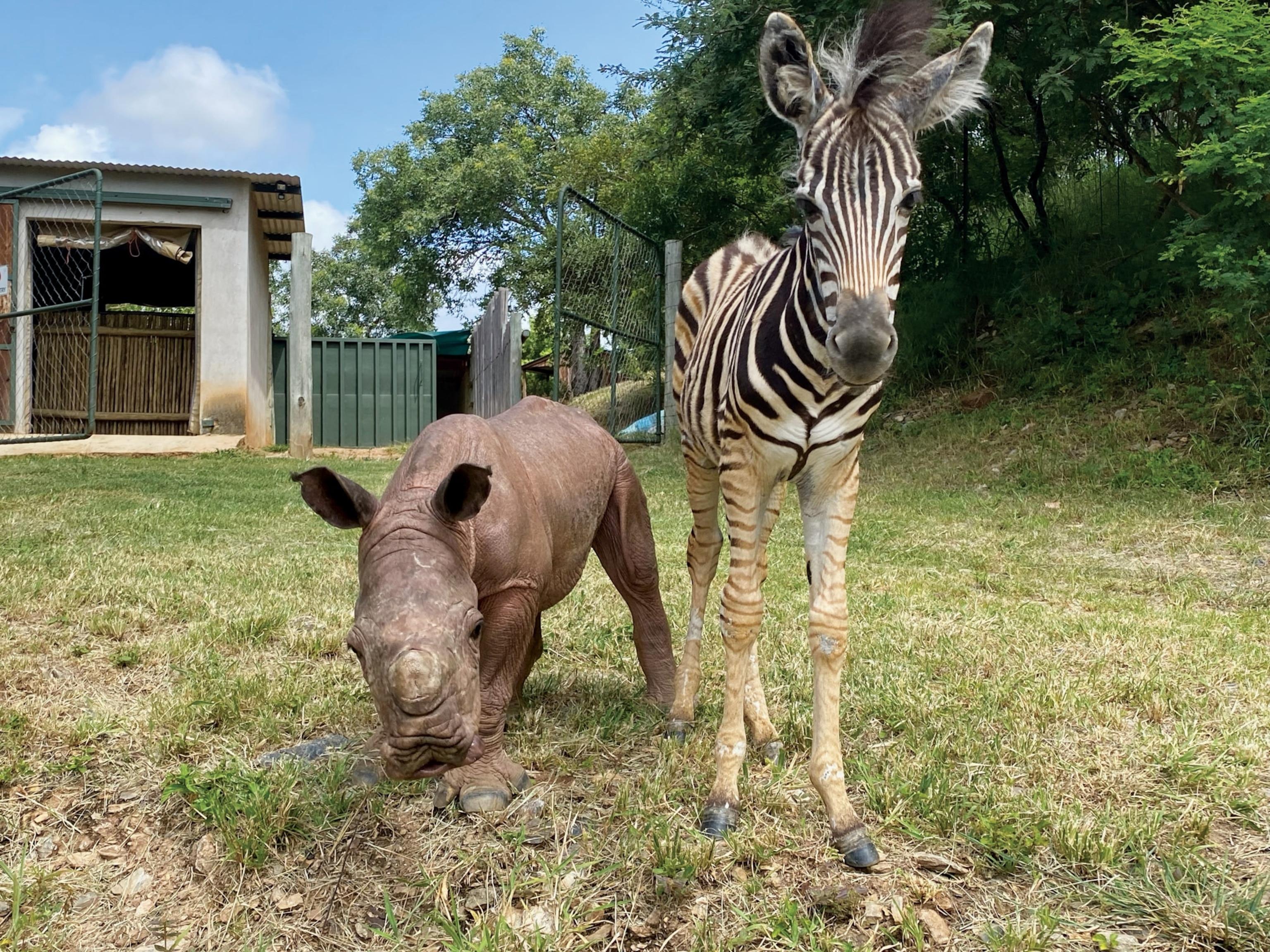
Why this rhino-zebra friendship makes perfect sense
- Environment
- Perpetual Planet
History & Culture
- History & Culture
- History Magazine
- Mind, Body, Wonder
- Terms of Use
- Privacy Policy
- Your US State Privacy Rights
- Children's Online Privacy Policy
- Interest-Based Ads
- About Nielsen Measurement
- Do Not Sell or Share My Personal Information
- Nat Geo Home
- Attend a Live Event
- Book a Trip
- Inspire Your Kids
- Shop Nat Geo
- Visit the D.C. Museum
- Learn About Our Impact
- Support Our Mission
- Advertise With Us
- Customer Service
- Renew Subscription
- Manage Your Subscription
- Work at Nat Geo
- Sign Up for Our Newsletters
- Contribute to Protect the Planet
Copyright © 1996-2015 National Geographic Society Copyright © 2015-2024 National Geographic Partners, LLC. All rights reserved

The Big Five Animals
All about ‘the big five’ animals – african elephant, cape buffalo, leopard, lion, rhinoceros, the big five animals of africa are african elephant, cape buffalo, leopard, lion, and rhinoceros.
These five types of animals were named ‘the big five’ by big game hunters from African’s colonial era, as they were considered the most difficult and dangerous African beasts to hunt on foot. These days, of course, any shooting of Africa’s big five tends to be more about choosing the right lens ( photo safari anyone? )!
Jump to a section: African Elephant | Cape Buffalo | Leopard | Lion | Rhinoceros | Big five quotes | Best places to see the big five | Other wildlife ‘5s’
Read on below for a more in-depth look at each of the big 5 animals:
1. African Elephant
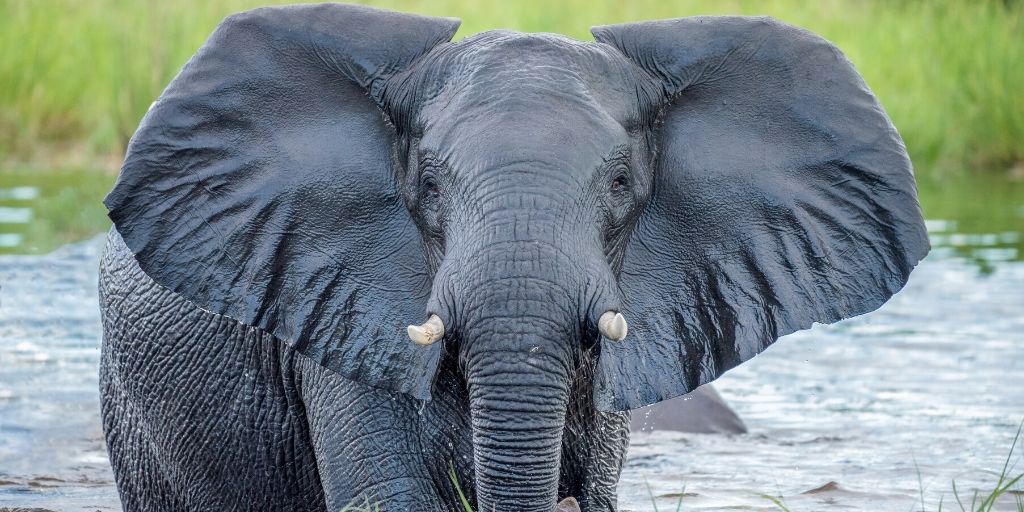
African elephants are the largest of the big five animals
The African elephant ( Loxodonta africana ) is the largest and heaviest land animal in the world, weighing up to 6 tonnes, and eating massive amounts of food each day.
Their distinguishing features include the dexterous trunk , large ears that cool the body when flapped, and elongated incisors in the form of tusks. There are actually two species of African elephant – the African bush elephant and the smaller African forest elephant. Both are herbivores that live in large groups, whilst the African bush elephant is the larger of the two species, and typically the species referred to as a member of the big five animals.
A bull elephant can be dangerous, as can herds or mothers with young elephants. Keep your distance from them, and if in a vehicle ensure that you have the means to drive away forwards – elephants can run faster than a car can reverse. An elephant flapping its ears, kicking up dust, and/or trumpeting is probably about to charge.
Group name: Herd
Size: Up to 3.3 meters tall, weighing 6,000kg.
Speed: Up to 40 km per hour.
Diet: Elephants are vegetarians, eating up to 160kg per day, made up of savannah grasses, bushes, small plants, fruit, twigs, tree bark, and roots. Read more about what elephants eat .
Range & Habitat: African Elephants are found across sub-Saharan Africa – from Mali in the north, through the central and west African forests, down to South Africa. They are adaptable animals, capable of surviving in many habitats, from lush wetlands to arid African deserts . Despite this, both species of African elephants are considered endangered species , and on the list of Africa’s most endangered animals .
Best places to see African elephants: Addo Elephant Park, South Africa, Chobe National Park , Botswana , Etosha National Park, Namibia , Hwange National Park, Zimbabwe , South Luangwa National Park, Zambia .
Read more about African elephants .
2. Cape Buffalo

A grumpy African buffalo
Weighing in at not too far short of a ton, the African buffalo ( Syncerus caffer ) has a reputation for being bad-tempered and dangerous. Whilst a solitary African buffalo is one of the most unpredictable safari animals (and dangerous, hence their inclusion in the term big five animals), they are usually a docile beast when in a herd… aside from their tendency to stampede en masse when alarmed.
Herds have clearly defined home ranges, the size of which is determined by the amount of food and water available.
Size: Up to 1.8 meters tall, and 800kg in weight.
Speed: They can run at speeds of up 57 kilometers per hour.
Diet: Cape buffalos are strictly herbivores and eat a wide variety of grasses, leaves, and other plants.
Habitat & Rage: Cape buffalo thrive in all sub-Saharan grasslands with access to water – from dry savanna to lowland floodplains.
Best places to see African Buffalo: Chobe National Park , Botswana , Katavi National Park, Tanzania , Kruger National Park, South Africa , Lower Zambezi National Park, Zambia.
Learn more about Cape Buffalo.
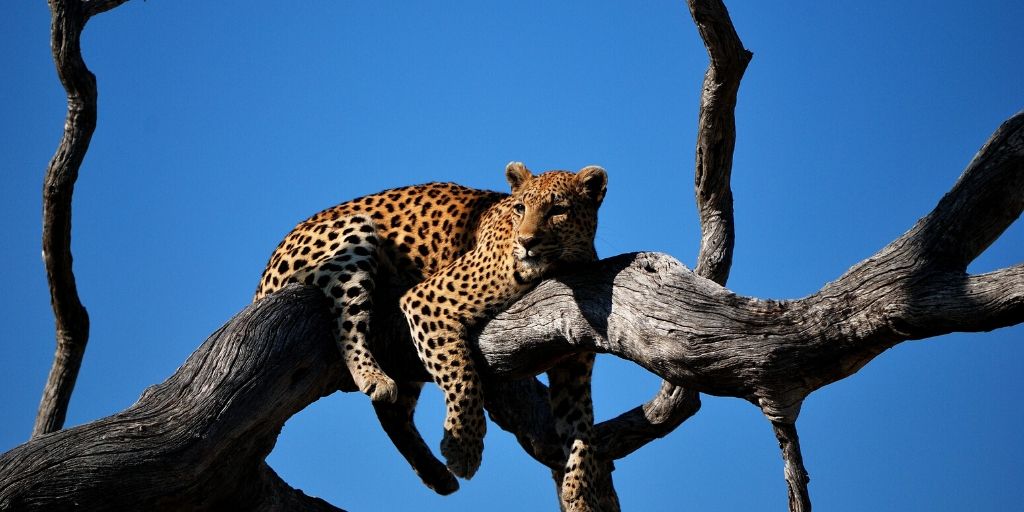
A stunning African leopard lounges in a tree in Kruger National Park, South Africa
Slightly smaller than their lion cousins, African leopards ( Panthera pardus ) are less rare than you might think, but rely on their animal camouflage and being active at night to stay hidden. Leopards are solitary, independent creatures, and rarely seen together except during mating, or a mother with cubs. As such they are totally self-reliant, and expert hunters – sometimes killing prey up to twice their size. During the daytime they often lounge around in trees and come to the ground after dark to hunt, taking their prey up into a tree to eat at their leisure.
Group name: Leap
Size: 1 meter high, weighing up to 100 kg.
Speed: 56 kilometers per hour.
Diet: Leopards are opportunistic carnivores and hunt a wide range of prey such as jackals , antelopes, gazelles , African monkeys , duiker, eland , impala , wildebeest , and more.
Range & Habitat: African leopards live in more places than any other types of big cat in Africa, and are comfortable in almost any habitat, including deserts, rainforests, woodlands, grassland savannas, mountain, scrub, and swamps. Leopards are one of the few big game species found outside national parks.
Best places to see Leopard: Londolozi Game Reserve, South Africa , Moremi Game Reserve , Botswana , Samburu National Reserve, Kenya, South Luangwa National Park, Zambia .
Learn more about leopards.

A male African lion and lioness relaxing
The African lion is the largest and most sociable of Africa’s cats , and one of Africa’s most dangerous animals . At up to 225kg, the lion ( Panthera leo ) really is the king of the savanna (it’s not a jungle animal !). Living in prides of up to 40 lions, it’s the lionesses who do all the hunting, usually sharing with the males of a pride. Lions are very territorial, and the females generally spend most of their lives within their home ranges.
If you encounter an African lion on foot don’t turn and run (easier said than done), as a running target that looks like prey will probably be viewed as such. Instead, try to make yourself look big, and back away gradually.
Group name: Pride
Size: 1.2 meters, weighing up to 225kg.
Speed: At a maximum speed of 80 kilometers per hour, the lion is the second fastest land animal in Africa .
Diet: African lions are apex predators and generally hunt the larger animals in their surroundings – buffalo, rhino, zebra, giraffe, and antelopes. Learn more about what lions eat .
Range & Habitat: Lions tend to prefer grassland, savanna, dense scrub, and open woodland. They are found across sub-Saharan African national parks, and also in a small part of north-east India.
Best places to see Lion: Kgalagadi Transfrontier Park, South Africa, Kruger National Park, South Africa , Maasai Mara National Reserve, Kenya , Ngorongoro Conservation Area, Tanzania , Okavango Delta, Botswana .
Read more about lions.
5. Rhinocerous

A white rhino walking in the bush
Once widespread through sub-Saharan Africa, the rhino has been hunted to the brink of extinction, and is probably the hardest of the big five to spot in the wild.
There are two species of rhinoceros in Africa – the critically endangered black rhino ( Diceros bicornis ) and the white rhino ( Ceratotherium simum ). Whilst white rhinos have made a comeback through conservation efforts across the continent, black rhinos are still very much one of Africa’s endangered animals . The fundamental differences between the white rhino and black rhino are not color, but rather size, temperament, food preference, and mouth shape. White rhinos have a flat, wide mouth, and their name comes from a mispronunciation of the Afrikaans word wide – “wijd”.
Both black rhinos and white rhinos tend to be wary of humans, but occasionally charge vehicles that get too close. If you’re on foot, then their bad eyesight should work in your favour – if they do charge you the apparent life-saving technique involves letting them get as close as possible, then stepping aside at the last second.
Group name: Crash
Size: 1.9 meters high and weighing up to 2,300kg
Speed: 50 kilometers per hour
Diet: All species of rhino are herbivores, grazing on a wide variety of fruits, stems, twigs, grasses, and leaves.
Range & Habitat: White rhinos are found throughout Asia and sub-Saharan Africa in habitats ranging from dense rainforests and swamps to grassy plains.
Best places to see Rhinoceros: Tends to be in Southern Africa – Etosha National Park , Namibia , Hluhluwe–Imfolozi Park, South Africa , Kruger National Park , South Africa, Lewa Wildlife Conservancy, Kenya , Mkomazi National Park, Tanzania.
Learn more about rhinos.
Best places to see all of the big five animals
Whilst we’ve highlighted national parks above to see each of the members of the big five animals, the ultimate thrill is to see all five animals on one safari. It’s not easy – not least because even if all five animals are present in an area they can still be very difficult to see! However, it is possible, as there are a number of hotspots in southern and east Africa that are rich in variety and can support an extremely dense wildlife population. Our top picks to see all of the big five together are:
- Chobe National Park, Botswana
- Etosha National Park in Namibia
- Kruger National Park in South Africa
- Londolozi Game Reserve in South Africa
- Maasai Mara National Reserve, Kenya
- Moremi Game Reserve, Botswana
- Ngorongoro Conservation Area, Tanzania
- South Luangwa National Park in Zambia
5 great quotes about each of the big five animals
Elephant quotes.

“They say an elephant never forgets. What they don’t tell you is, you never forget an elephant.”
Bill Murray
“Nature’s great masterpiece, an elephant; the only harmless great thing.”
“If anyone wants to know what elephants are like, they are like people only more so.”
Pierre Corneille
“He who mounts a wild elephant goes where the elephant goes.”
Randolph Bourne
Lion quotes

“Do not try to fight a lion if you are not one yourself.”
African proverb
“You know you are truly alive when you’re living among lions.”
Isak Dinesen
“Until the lion tells his side of the story, the tale of the hunt will always glorify the hunter.”
Zimbabwean proverb
“Lions make leopards tame.”
William Shakespeare
“In the jungle, the mighty jungle The lion sleeps tonight.”
Solomon Lina, “Mbube”
Leopard quotes

“At the top of the mountain we are all snow leopards. “
Hunter S. Thompson
“The leopard does not change his spots.”
King James Bible
“This world without a leopard…I mean, who would want to be here?! “
Diana Vreeland
“Leopard is an animal design, and my designs come from nature. “
Roberto Cavalli
“A leopard feels at home with leopard. “
George Eliot
Buffalo quotes
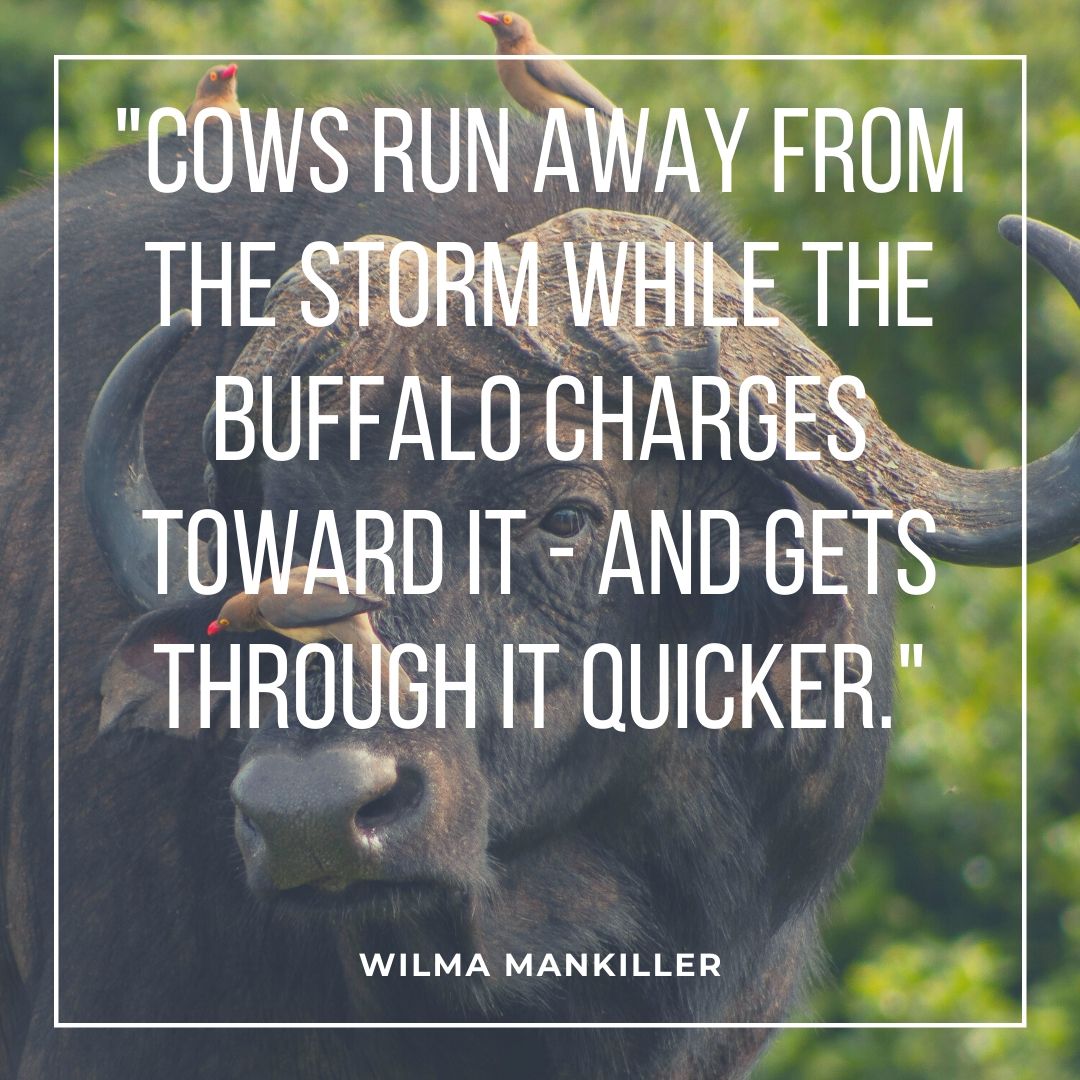
Cows run away from the storm while the buffalo charges toward it – and gets through it quicker. Whenever I’m confronted with a tough challenge, I do not prolong the torment, I become the buffalo.
Wilma Mankiller
The buffalo is a surprisingly stupid animal.
Ellsworth Huntington
So is the savage buffalo, especially delighting in dark places, where he can wallow in the mud and slake his thirst without much trouble
John Hanning Speke
At the rate science proceeds, rockets and missiles will one day seem like buffalo – slow, endangered grazers in the black pasture of outer space.
Bernard Cooper
The coat of the buffalo never pinches under the arm, never puckers at the shoulders; it is always the same, yet never old fashioned nor out of date.
Theodore Parker
Rhino quotes
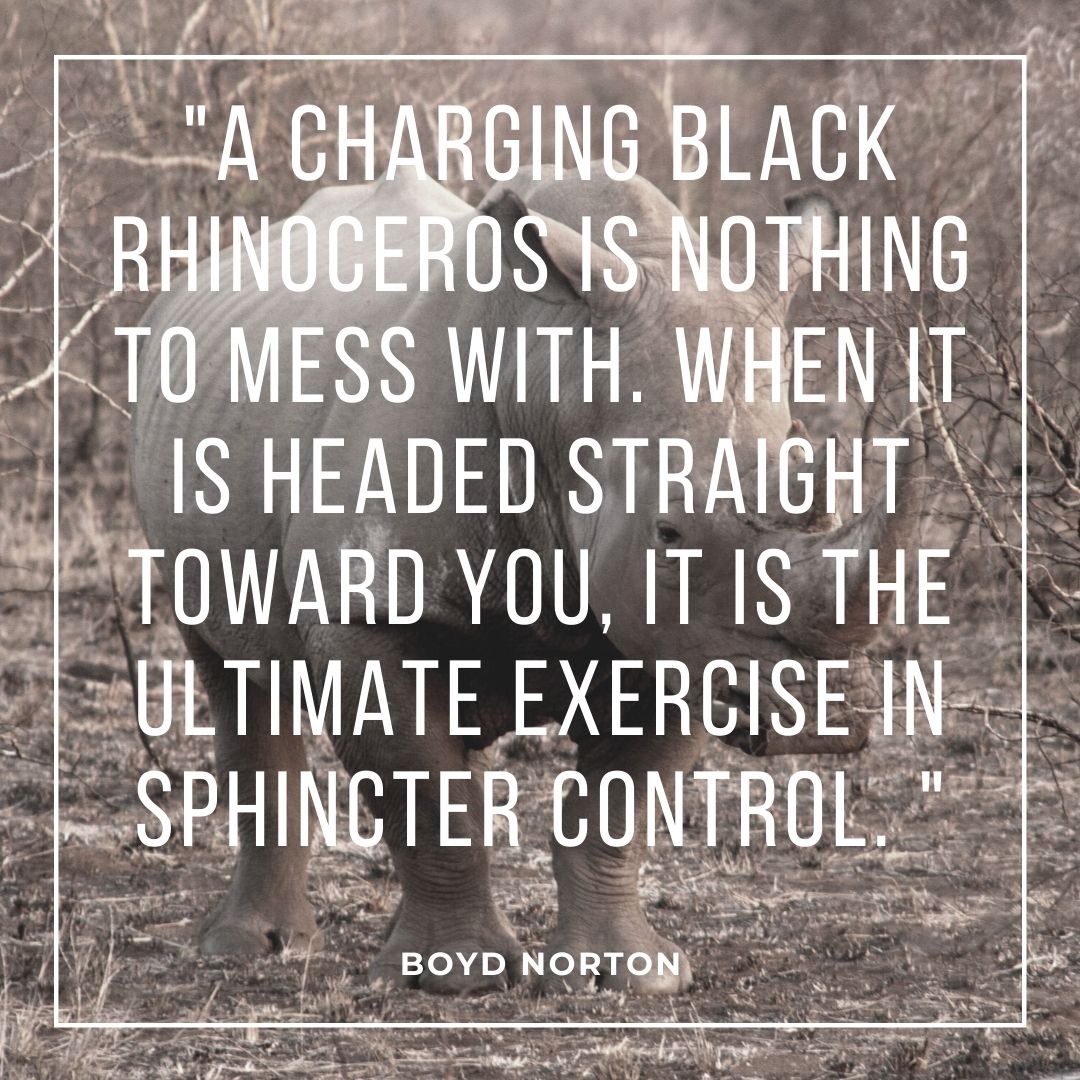
A charging black rhinoceros is nothing to mess with. When it is headed straight toward you, it is the ultimate exercise in sphincter control.
Boyd Norton
It is one thing to be amazed at gorgon or a griffin, creatures which do not exist; but it is quite another and much higher thing to be amazed at a rhinoceros or a giraffe, creatures which do exist and look as if they don’t.
G.K.Chesterton
The only way to save a rhinoceros is to save the environment in which it lives, because there’s a mutual dependency between it and millions of other species of both animals and plants.
David Attenborough
The rhinoceros stood about five hundred yards away, not a twentieth-century animal at all, but an odd, grim straggler from the Stone Age.
Winston Churchill
A rhinoceros is as ugly as a human being, and it too is going to die, but at least it never thinks that it is beautiful.
Peter S. Beagle
Other wildlife ‘fives’
Have you seen the big five animals and are are looking for a new wildlife challenge – other animals to hunt for your photo safari? For safari aficionados up for ticking all the ‘I’ve seen’ boxes, have you heard about the other groups of 5 animals?
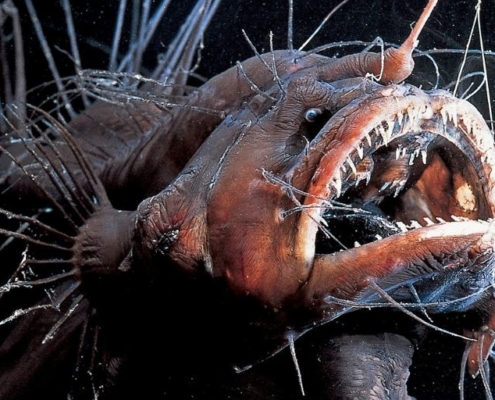
World’s Ugliest Fish
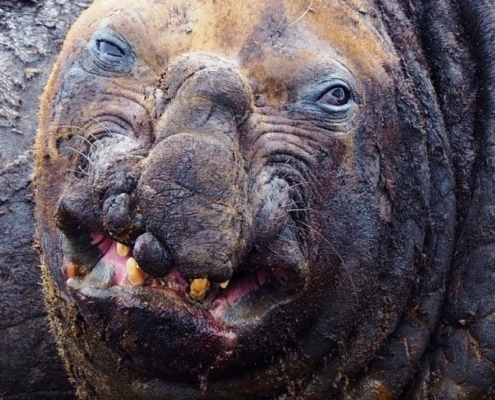
Ugly Animals
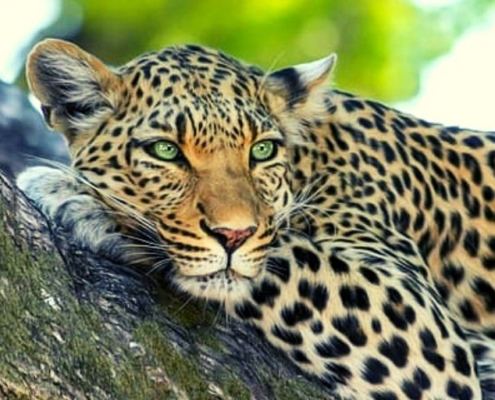
Best Places For The Big 5 In South Africa
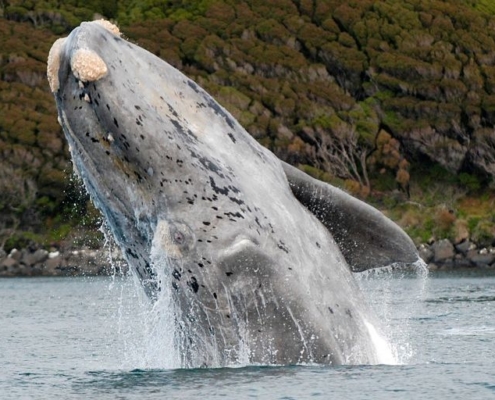
The Big Seven Animals – What They Are & Where To See Them
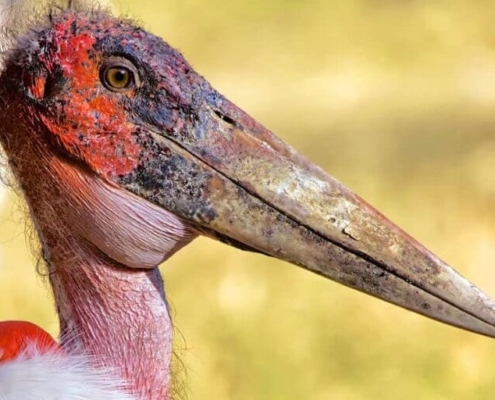
What Are ‘The Ugly Five’ Animals?
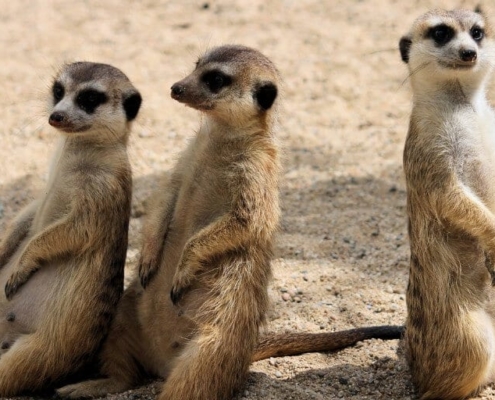
What Are ‘The Shy Five’ Animals?
Discover more of our wildlife posts…, african animal baby names, 13 iconic rainforest animals, jaguar v leopard, which is which, the fastest birds in the world – air, land & sea, what are the most dangerous animals, understanding keystone species, seal vs sea lion: how to tell the difference, fastest snakes in the world.
I like the big five very much, but alittle bit surprised. The hippo i big than lion and leopard why is it not on the list. We heard that hippos are one of the animals which kills more people than elephants and rihnos
Hippos mainly live in the water, the Big Five live on land.
Hi Martin, the name is not everything! Hippos weren’t in the group of animals hunted for their skin or heads, so didn’t make the big five list ;)
The Big five are the animals that i love so much but they left the TIGER and its deserves to be on of them… if one could make them pets i’d long had one.
Unfortunately tigers are not native to Africa.
The big five is found all over Kenya and other parts of Africa.
Big five are found in Africa most distinctive in Tanzania, am proud of it.
My best animals are the big five
In my opinion the “Big Five” and all other wild animals wherever they are in the world should not be hunted down by big game hunters or poachers and the cowards who carry out these atrocities should themselves be hunted down and prosecuted to the fullest by the governments of those countries in which those activities occur.
Absolutely agree Eric – big game hunting is not something I can say I’m a fan of…
very useful to my resarch…
Glad to hear it Ryan ;)
Top countries for safaris
- Botswana safaris
- Kenya safaris
- Namibia safaris
- South Africa safaris
- Tanzania safaris
- Uganda safaris
Safari basics
- Safari animals
- How to find the right safari company
- When to go on safari
- What to take on safari
- Safari clothing – what to wear
- Safari rules & etiquette
- Wildlife spotting tips
Most read articles
- All about the ‘big five’ animals
- Collective nouns for animals
- Safari movies to watch before you go
- The world’s fastest land animals
- Apex predators
- 10 Fascinating African tribes
- The biggest animals in the world
- 17 Epic hybrid animals
- The world’s ugliest animals
- Why are flamingos pink?
Africa’s best game reserves
- Chobe National Park, Botswana
- Etosha National Park, Namibia
- Kruger National Park, South Africa
- Masai Mara National Reserve, Kenya
- Okavango Delta, Botswana
- Serengeti National Park, Tanzania

Session expired
Please log in again. The login page will open in a new tab. After logging in you can close it and return to this page.
An Introduction to Africa's Big Five Safari Animals
:max_bytes(150000):strip_icc():format(webp)/anoukmarrakech-56a373305f9b58b7d0d20299.jpg)
TripSavvy / Vin Ganapathy
If you're planning an African safari , you'll know that the term 'Big Five' is one of the most commonly used marketing slogans in the safari industry. Game reserves that host the Big Five will usually use this fact as their most significant selling point—but what does it mean? In the game reserves and national parks of Southern Africa , the Big Five represents safari royalty: the African lion, the African leopard, the African elephant, the Cape buffalo, and the rhino (either white or black).
The phrase was initially coined by early game hunters who recognized that these species were the most challenging and most dangerous animals to hunt on foot. This made them the biggest prizes, hence, the Big Five. Today, the phrase has come to represent the most sought-after safari sightings—although, in reality, this is a matter of personal preference. Some of the most endangered, beautiful, or charismatic African animals don't feature on the Big Five list, including the cheetah , the African wild dog, the giraffe, and the hippo.
African Elephant
The African elephant ( Loxodonta africana ) is the world's largest and heaviest land animal, with the biggest individual on record weighing in at over 10 tons/22,000 pounds. They are found in 37 sub-Saharan countries and can survive in a wide range of different habitats, from lush wetlands to arid deserts.
African elephants are supremely well adapted to their environment, from their inch-thick skin (which protects them from the sharp thorns of the bush) to their enormous ears (which help to disperse heat and regulate body temperature). They can consume up to 50 gallons of water and 375 pounds of vegetation every day.
Elephants are very social animals. They live in matriarch-led groups that often number more than 100 individuals and communicate using a variety of low-frequency rumbles that can travel for many miles. Female calves usually stay with the herd throughout their life, while young males leave to form bachelor groups and eventually create herds of their own.
In the 1970s and '80s, the global demand for ivory led to a dramatic decrease in elephant numbers. A ban on all ivory trade has helped stabilize the population to around 600,000 in the last decade. However, poaching is still a major issue, especially in parts of Africa where there is political instability. The African elephant is listed as Vulnerable on the IUCN Red List .
Where to See Elephants: Chobe National Park , Botswana; Addo Elephant National Park , South Africa; Hwange National Park , Zimbabwe; South Luangwa National Park, Zambia.
African Lion
The African lion ( Panthera leo ) is the undisputed king of the sub-Saharan savannah and is the world's second-largest cat after the tiger. Although lions sometimes hunt during the day, they are typically more active at night which is why most daytime safari sightings are of cats sleeping in the shade. Lions can sleep for up to 20 hours a day.
Unlike other cats, lions are very social animals. They live in prides, usually consisting of one (or sometimes two) males, several females, and their cubs. Lionesses typically do the hard graft when hunting, often working together to bring down larger prey. They are ambush hunters, using their tawny coloring as effective camouflage.
In the wild, lions can live to around 14 years, although most prides experience a high rate of cub mortality, while males often die while fighting to protect their territory. Female lions can synchronize the birth of their cubs to help each other raise them. Cubs are born with rosette markings that fade over time.
Lions have few natural predators, although buffalo will often trample cubs. Predictably, man is the species' biggest threat. Traditional hunting customs , big game hunters, and large-scale habitat loss have contributed to declining lion populations in Africa. The lion is also classified as Vulnerable on the IUCN Red List.
Where to See Lion: Kgalagadi Transfrontier Park, South Africa; Okavango Delta , Botswana; Maasai Mara National Reserve , Kenya, Ngorongoro Conservation Area, Tanzania.
African Leopard
The African leopard ( Panthera pardus ) is the most elusive of the Big Five animals. Naturally shy and exclusively nocturnal, leopards spend the daylight hours hidden from view. They are excellent climbers, using trees to scan for prey and store fresh kills away from scavengers like lions and hyenas. If you're looking for a leopard, remember to look up.
Leopards are superbly camouflaged with a series of black spots or rosettes. They have large territories and seldom stay in the same area for more than a few days. Males range more widely than females and mark their presence by urinating and leaving claw marks. They are powerful and can take down prey much larger than themselves.
Their hunting prowess relies on their ability to run at speeds of over 35 miles per hour. They can also jump over 10 feet into the air and are excellent swimmers. Leopards are distributed throughout sub-Saharan Africa and are one of the few big game species still found outside national parks.
White spots on the tip of their tails and the back of their ears make mothers visible to their cubs even in the long grass. As with the other Big Five species, leopards are threatened by humans. Encroaching farmlands have reduced their habitat, while farmers often shoot them to stop them from killing their livestock. They are listed as Vulnerable on the IUCN Red List.
Where to See Leopard: Londolozi Game Reserve, South Africa; Moremi Game Reserve, Botswana; South Luangwa National Park , Zambia; Samburu National Reserve, Kenya.
Cape Buffalo
Cape buffalo ( Syncerus caffer ) are found in water-rich game reserves and national parks throughout sub-Saharan Africa. There are four sub-species of Cape buffalo, the largest of which is the one most commonly seen in East and Southern Africa.
Cape buffalo are formidable creatures and have earned themselves a reputation as one of the most dangerous animals in Africa. They are often bad-tempered, especially when threatened, and are equipped with a fused set of deadly curved horns. Male buffalo can weigh as much as 2,000 pounds.
Despite their fierce reputation, buffalo are relatively peaceable with one another, sometimes congregating on the open grasslands in herds of over a thousand individuals. They are protective of their weaker members, often forming a defensive circle around sick or young animals when under attack from prowling lions.
Cape buffalo need to drink every day and are often found close to water. They eat tall, coarse grass and bushes, and as such cannot live in the desert. Cape buffalo continue to be one of the most sought-after trophy animals for big game hunters. They are exceptionally susceptible to domestic cattle diseases like rinderpest and bovine tuberculosis.
Where to see Cape Buffalo: Kruger National Park, South Africa; Chobe National Park, Botswana; Katavi National Park , Tanzania; Lower Zambezi National Park, Zambia.
White and Black Rhino
There are two rhino species in Africa: the black rhino ( Diceros bicornis ) and the white rhino ( Ceratotherium simum ). Both are at risk of extinction due to the poaching epidemic caused by the demand for rhino horns in Asian cultures. It is estimated that there are around 5,000 black rhinos and 20,000 white rhinos left in the wild.
Three subspecies of black rhino have been declared extinct, while the northern white rhino is now extinct in the wild. Conservationists are working tirelessly to protect the remaining sub-species, but their futures are far from secure. The black rhino is listed as Critically Endangered on the IUCN Red List.
Despite their names, there is no difference in color between the black and the white rhino. The easiest way to tell the species apart is to look at their lips—the black rhino's are pointed and prehensile, while the white rhino's are flat and wide. The Dutch word for "wide" is "wijd," and it is a mispronunciation of this word that gives the white rhino its name.
Black rhinos are usually solitary and have a reputation for being bad-tempered, while white rhinos often live in pairs. Black rhinos prefer desert and scrubland areas and are herbivorous browsers, while white rhinos graze on open savannah areas. It is thought that rhinos have roamed the African plains for 50 million years.
Where to See Rhino: Etosha National Park , Namibia; Hluhluwe–Imfolozi Park, South Africa; Lewa Wildlife Conservancy , Kenya; Mkomazi National Park, Tanzania
15 Animals to See on an African Safari
Forgotten Felines: The Seven Small Cats of Africa
Top 10 Unmissable African Safari Destinations
The Top 12 National Parks to Visit in Africa
Serengeti National Park, Tanzania: The Complete Guide
The Best Places to Go in Southern Africa
The Top 5 Places to See Lions in Africa
Top 5 Self-Drive Safari Destinations in Southern Africa
Hluhluwe-Imfolozi Park, South Africa: The Complete Guide
Kruger National Park: The Complete Guide
10 of the Best Private Game Reserves in South Africa
Nairobi National Park: The Complete Guide
South Luangwa National Park, Zambia: The Complete Guide
Chobe National Park: The Complete Guide
Top 10 Destinations in Africa for a First-Time Visitor
12 Best Things to Do in Kenya
- Travel Website
- Travel trade website
- Business events website
- Corporate & media website
- Welcome to South Africa
- What you need to know
- Things to do
- Places to go
- Get in touch
Choose your country and language:
- South Africa
Asia Pacific
- South Korea
- Netherlands
- United Kingdom
By creating an account, I agree to the Terms of service and Privacy policy
Wildlife safari
The big five.
E E ven though you know that Africa and South Africa are so much more than the Big Five, the familiar images soon begin playing in your mind: lions roaring; elephants trumpeting; buffalos lurking in long grass; rhinos standing stately under a thorn tree; leopards prowling in the gathering darkness.
You’ve seen the Big Five in books and you’ve seen them on TV. But it’s time to come and see them for yourself. The real thing. In person.
And there’s no better place for this than South Africa, which offers the most exciting, memorable and exhilarating experience of your life – coming face to face with the Big Five.
Origin of the name
How did these five animals – the lion, elephant, buffalo, rhinoceros and leopard – come to be called the Big Five?
It was originally a hunting term used by the so-called ‘great white hunters’ in the hunting heyday of the 19th and early 20thcenturies, when professional hunters bagged as many trophies as possible in as short a time as possible.
Considered a rite of passage for seasoned travellers, everybody from American presidents to European royalty and heads of state came to Africa to shoot a large, dangerous animal.
The Big Five quickly became known as the most dangerous animals to hunt on foot, and the name stuck – although now ‘shooting’ is done through a camera lens.
T T he Lion
The lion is arguably the most sought-after of the Big Five because it is synonymous with an African safari. Charismatic, powerful and beautiful, everybody wants to see the appropriately named 'King of the Beasts'.
Once, hundreds of thousands of lions roamed the world, but today conservationists give approximate numbers of between 25 000 and 30 000 left, most in sub-Saharan Africa. In South Africa, your chances of seeing lions are high, whether in our national parks or in private game reserves.
Lions are creatures of the savannah and open plains (you’ll rarely find them in a forest) and function in prides, usually numbering about five to 15, depending on the territory – although the Kruger National Park is known to have at least one big pride of up to 25 animals.
They are social family animals – related females rule, usually alongside a large dominant male that has won the pride in fierce competition with other males. Lionesses stay with the pride, while young males leave at two to three years of age. Males sometimes form coalitions to enhance their hunting success, but you’ll rarely see one with more than four lions.
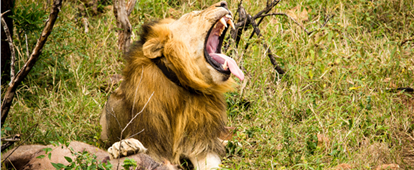
L L ionesses start breeding at four years old, and typically give birth to a litter of three or four cubs after 14 to 15 weeks of gestation. Lionesses of the same pride often give birth at or near the same time as their ‘sisters’, which allows for communal suckling and round-the-clock care.
And don’t expect to see an old lion – they are defeated in battle, often die of their wounds or are no longer able to hunt. Lions are in their prime from five to nine years of age. Male lions, once they’ve taken over a pride, have to work hard to keep it. Younger males – with attitude – are always on the sidelines.
Some prides specialise in hunting certain animals and develop specialised skills for this prey of choice – young elephants, ostrich, wildebeest.
Lions have no natural enemies other than hunters, although lion cubs fall prey to nomadic male lions that kill them in attempting to take over a pride. Hyenas, leopards and wild dogs also kill lion cubs.
T T he Elephant
Perhaps it’s the African elephant that should be called ‘King of the Beasts’ – it is the world’s largest and heaviest land animal. Its ears alone measure up to 2m x 1.2m (roughly the size of the surface area of a double bed) and can weigh up to 20kg (44lb) each, while it can grow to a height of more than 3m.
Elephants abound in South Africa – you can see great herds of more than 100 in the Kruger National Park or smaller breeding herds in private reserves.
Elephants are highly social animals and females rule. A herd will typically have a matriarch with vast cultural knowledge that leads the herd, keeps it under control and chooses its direction and pace. Even when feeding (and an adult elephant, arguably nature’s most versatile vegetarian, can eat up to 300kg of grass, bark, branches and foliage a day), the herd rarely strays far from the matriarch.
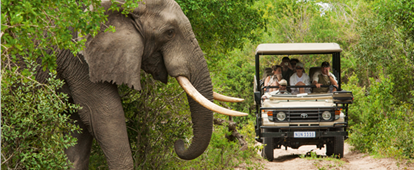
Y Y oung bulls leave the herd when they become teenagers and either live alone, form bachelor herds or seek the company of old lone bulls that have long left the herd.
Your first sighting of a tiny baby elephant will be one of your most indelible memories. How do these small creatures, some not yet reaching up to their mother’s tummy, avoid being stepped on or crushed by the herd? Mother, sisters, aunts and cousins are always on the alert. Watch how mothers protect their babies by always putting themselves between danger and their offspring, and how the whole herd immediately goes into protective group defence mode when threatened.
If an elephant trumpets, you’ll certainly hear it, but the infrasonic tummy rumbles they use to communicate with one another are most often too low for the human ear to pick up – although research shows that these calls have an elephant range of up to several kilometres.
And just because elephants are huge, don’t think they are slow; if a herd takes fright, or needs to move on quickly, elephants can reach speeds up to 40km/h – faster than you can run.
Elephants love water. To see a herd drinking, playing, splashing, swimming and dunking in the water will be another of your favourite safari memories.
T T he Buffalo
Don’t be fooled by the docile appearance of the Cape buffalo (also known as the African buffalo). This mean, moody and magnificent animal is possibly the most dangerous of the Big Five, especially if you are on foot.
Robert Ruark, the American novelist, wrote that ‘a buffalo always looks at you as if you owe him money’. Come face to face with a buffalo (preferably from the safety of a vehicle), and you’ll see exactly what Ruark meant – the stare is cold, calculating and cunning.
Buffalos are social animals and move around in large herds – sometimes of many hundreds – chomping long grass as they collectively move and feed. In the dry season, you can often see a cloud of dust signalling an approaching herd.
Buffalos have to drink daily, and to witness a large herd approaching a waterhole – often in the early morning or late afternoon – is a memorable and noisy experience.
It’s quite easy to tell the males from the females. The males are blacker, bigger and have huge powerful horns that are joined in the middle to form a ‘boss’. When buffalos fight for rank and females (buffalos are non-territorial and don’t fight for territory like some others of the Big Five), the noise of the clashing and crashing of their bosses is awesome. It is estimated that the impact of their horns’ collision is equal to a car hitting a wall at 50km/h.
Females are smaller, more reddish-brown in colour, and their much narrower horns don’t meet in the middle. Calves are usually born in the rainy season, and although they can stand up on wobbly legs immediately, it takes several weeks until they can keep up adequately with the herd.
Although most of a buffalo’s senses are well developed, it’s their super-charged hearing that helps them find food and alerts them to danger. There’s usually a dominant male – or more if the herd is huge – that stays in the middle of the herd, as well as ‘pathfinders’, which may not be the biggest and best, but lead the herd and keep it together.
You may also see a group of old bulls together – caked in mud from wallowing.
These are known as ‘Dagha Boys’ after the ‘dagha’, or mud, the Zulus used to build their traditional huts.
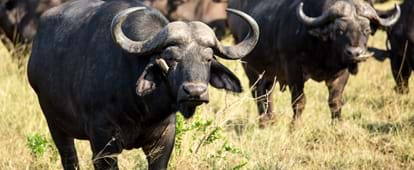
I I t’s quite easy to tell the males from the females. The males are blacker, bigger and have huge powerful horns that are joined in the middle to form a ‘boss’. When buffalos fight for rank and females (buffalos are non-territorial and don’t fight for territory like some others of the Big Five), the noise of the clashing and crashing of their bosses is awesome. It is estimated that the impact of their horns’ collision is equal to a car hitting a wall at 50km/h.
T T he White Rhino
Your first impression will be of its bulk and size. And then you may wonder how such a prehistoric-looking animal has existed for so many millions of years. Although unfortunately, the brutality and intensity of present-day poaching is a serious threat to the continuing survival of the species.
The second-largest land mammal, the white rhino’s name has nothing to do with its colour. It was the early Dutch settlers who referred to the animal’s broad lips as ‘wyd’ (wide), misinterpreted later as ‘white’.
This is a remarkable animal, weighing in at nearly 2 500kg (about 5 500lb) and often living up to 40 years of age. Because it is a grazer, eating thick, tough grass, it needs lots of water to digest its food, and needs to drink at least once daily. Sometimes you’ll see a rhino eating mud or soil, which acts as a dietary mineral supplement.
Its horn is used for fighting and defence and is not attached to the skull in any way.
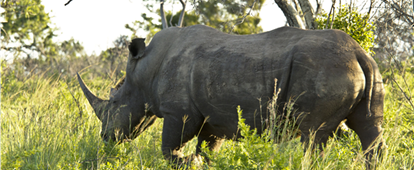
F F emales live together in small groups, individuals breaking away when a determined bull decides to mate. Only one calf is born to a female at a time; the cow is very protective of her calf and will fight off an aggressive bull if necessary.
The calf always runs in front of its mother if they are fleeing from danger (a black rhino calf, on the other hand, will run behind its mother).
You’ll often find a white rhino resting in shade in the heat of the day or wallowing in mud. The dried mud acts as a sunscreen, a cooling agent and helps evict parasites that break off with the dried mud.
Look out for rhino middens beside the road. These are huge heaps of dung, used regularly by a particular male rhino to mark his territory. Females and non-dominant bulls also defecate on these middens, which act as markers and information signals to other rhinos.
Rhinos have poor eyesight but a fantastic sense of hearing and smell; watch a rhino’s ears – they constantly rotate in all directions as it works out what’s going on around it. And don’t think that because it’s so big and ungainly it’s a slow animal. If it’s running away (or chasing you), it can reach speeds of 40km/h.
The Black Rhino
The black rhino is smaller than its larger ‘white’ relative, is more solitary and elusive, and has a shorter head and beak-shaped lip that it uses for browsing leaves and twigs. Regarded as a more dangerous animal than the white rhino because of its volatile temperament, it is now one of the most endangered animals in Africa.
T T he Leopard
The one animal everybody wants to see – beautiful, charismatic, sexy and dramatic – and also the most elusive. The leopard is a solitary animal (unless mating, or a mother with cubs) and will, whether male or female, fiercely defend its own hunting territory from other leopards.
Considered to be one of the most successful, if not the most successful, of all African predators, the leopard is a master stalker. If you are lucky, particularly on a night drive (as leopards are nocturnal animals), you may see a leopard stalking its prey – silently, ruthlessly – before getting to within 5m of the prey and then launching itself with a powerful spring. Surprise is its chief means of attack.
Leopards often athletically drag their prey up into trees (sometimes the dead animal is as heavy as the leopard) to avoid having it pirated by other animals, particularly lions and hyenas.
Look out for thick overhanging branches of big old trees – you may well find a leopard snoozing there during the hottest part of the day, or snacking on its prey.
Leopards take great pains to advertise their territories by scent marking, scraping the ground and defecating in exposed spots. They try to avoid confrontation with other leopards (unless protecting their territory) because, as solitary hunters, they can’t afford to get injured.
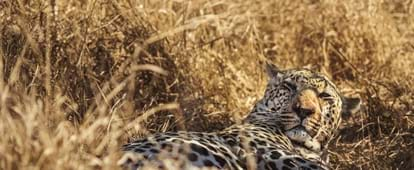
L L eopards make great mothers and take excellent care of their offspring, moving them from one place of safety to another when the cubs are very small – just as well, because young cubs are vulnerable to other leopards, lions, hyenas and wild dogs. Take a look at the black markings behind the ears and white tip of a mother’s long tail – these are signals for small cubs to follow.
That long tail is also used as a rudder for balance when the leopard is climbing a tree or hunting. A leopard also has long whiskers that it uses as antennae to judge spaces between bushes and trees – an essential tool for an animal that hunts at night.
Related articles
Netflix jiva - limpopo itinerary, this women's month take a girl's adventure to celebrate, the south african savanna – spotting the teeming life in bushveld grasslands, the sanbona wildlife reserve: awe-inspiring karoo landscapes in western cape, sabi sand private game reserve, mpumalanga: enjoy the big 5 from safari luxury, the r518 through the waterberg in limpopo: see the ancient waterberg red beds, pilanesberg national park, north west: spot the big 5 in an extinct volcano, the makuleke and kruger national park: how local people can benefit from south african tourism, south africa on social media.
The BMW International Open has made us excited for the BMW Golf Cup World Final to be hosted in SA. We caught up wi… https://t.co/XiU3waBo1T
Always a pleasure partnering with local businesses to promote SA on the global stage. Warren Weitsz, Co-Founder of… https://t.co/YRxoX6Jdtx
To say the players are bringing their A-game is an under statement! Round 2 has given us many unforgettable moments… https://t.co/4bBdAuXMUL
"...Patrons have been keen and interested in engaging on where the best fairways in SA are. Paired with some of our… https://t.co/tIoXM2uUrh
Our stand at the BMW International Open has been drawing a lot of attention – and rightfully so! “We are proud and… https://t.co/ulYSTje4CB
Clear skies, rolling greens, supportive crowds – the conditions couldn’t be better for a day at Golfclub München Ei… https://t.co/3TMmUxsN0m
What happens when an amateur and pro hit the fairway together? Find out in the Pro-Am Tournament, where 3 amateurs… https://t.co/hkvHUw0H0E
Ready to get into the swing of things? The Pro-Am Tournament of the 2023 BMW International Open starts today in Mün… https://t.co/WqLU7FshdH
South Africa has many exquisite golf courses. As we gear up for The BMW International Open in Germany, we hope to s… https://t.co/vTFwgOa78W
South African Tourism will be showcasing our beautiful country's offerings in Germany! We have so much to offer glo… https://t.co/O1m4yVy491
#DidYouKnow South Africa has produced some of the top golfers in the world. As we gear up for the BMW International… https://t.co/E1GsW6z1Fy
#DidYouKnow ? #VisitSouthAfrica ❤️🇿🇦 https://t.co/Y4zWjb8xIz
RT @Roberto_EUBXL: Amazing #YouthDay2023 long weekend in @MidlandsMeander ! Another 💎 of multifaceted #SouthAfrica : touches of 🇬🇧 🇧🇪 🇱🇺 co…
What does golf, South Africa, BMW and Germany have in common? The 34th staging of the BMW International Open in Ger… https://t.co/YdvuWOjs8O
Golf was first played in South Africa in 1885, in Cape Town. Now we are taking our love of golf to the world, as we… https://t.co/dXc5uIyGxI
RT @PublicSectorMan: Today marks 47 years since the youth uprising of 16 June 1976. Deputy President Paul Mashatile will lead the commemor…
We look forward to showcasing South Africa’s abundant tourism offerings to a global audience while reminding them a… https://t.co/yVz97hDGaa
A dynamic collaboration between SA Tourism and the iconic BMW Group is set to supercharge the country’s efforts tow… https://t.co/JhLDwHlLix
50 days until the kick-off – or shall we say the tip-off – of the Vitality #NWC2023 in SA! Excitement levels are at… https://t.co/Ni2fHwh2NJ
#VisitSouthAfrica ❤️🇿🇦 https://t.co/ApcA6wNNop

- Useful links
- Travel partners
- Business events
- Travel trade
- Accommodation
- Useful contacts
- Visa & entry info
- Digital Assets Library
- Image Library


What are the Big 5 of Africa?
Why are they called the big five animals, the big five animals in pictures, big five animal facts, where to find the big five in africa, what are the best big five safari destinations, what are the best places to see all of the big 5, when is the best time to see the big five in africa, the african big five and wildlife conservation status, other popular five animal combinations, learn about the big 5 on safari in africa, guide to the big 5 animals of africa, receive photography and travel tips.

What are the Big 5 animals of Africa and where to find them?
The Big Five animals of Africa , in short, 'The Big 5' include the African elephant , rhinoceros , lion , leopard , and Cape buffalo . These five big game animal species are found on the African continent in the Southern and Eastern parts of Africa. As the name suggests, they are not the heaviest or the 5 biggest safari animals.
If it was about the size or weight of the African animal , a gorilla or hippo could also easily fit in. A hippo is for example three times heavier than a Cape buffalo and a male gorilla and male lion can both weigh up to 225kg.
The Big Five game refers to the 5 African animals that big game hunters in the late 1800s, during Africa's colonial period, considered the most dangerous and difficult wild animals to track and hunt on foot. Hunting these African game animals got them the biggest prices and trophies. Dangerous, because of their behavior when they feel threatened or get injured. Sadly, this wildlife is still hunted today but luckily there are also a lot of conservation initiatives to protect these threatened species that are decreasing in population and struggling because of habitat loss.
Nowadays, the term 'Big Five' is more a commercial term used by safari companies to sell their 'African Big 5 Safari trips' and to describe the Top 5 safari animals to see on a game drive . This made them also the most famous large African animals to look for on a safari trip to Africa. Ticking off the Big 5 is therefore on many travelers’ bucket lists. However, there's much more wildlife worth seeing roam freely in their natural habitat, like the cheetah, a tall elegant giraffe, a spotted Hyena, or a pack of African wild dogs. Even smaller creatures, like Dung Beetles or all the colorful birdlife, play an important role in the ecosystems.
So, with this article, I also want to raise awareness about the fact that there's more to Africa than spotting the Big Five , which is a hunting term after all.
That is also the main reason for setting up the New Big Five project, an international initiative to create a new Big Five of wildlife: the Big Five of wildlife photography where it's about shooting with a camera instead of hunting with a gun. The aim of this project is to raise awareness about the crisis facing the world's wildlife from threats, including habitat loss, human-wildlife conflict, poaching, illegal wildlife trade, and climate change.
The Big 5 safari animals of Africa in one black and white photo collage.
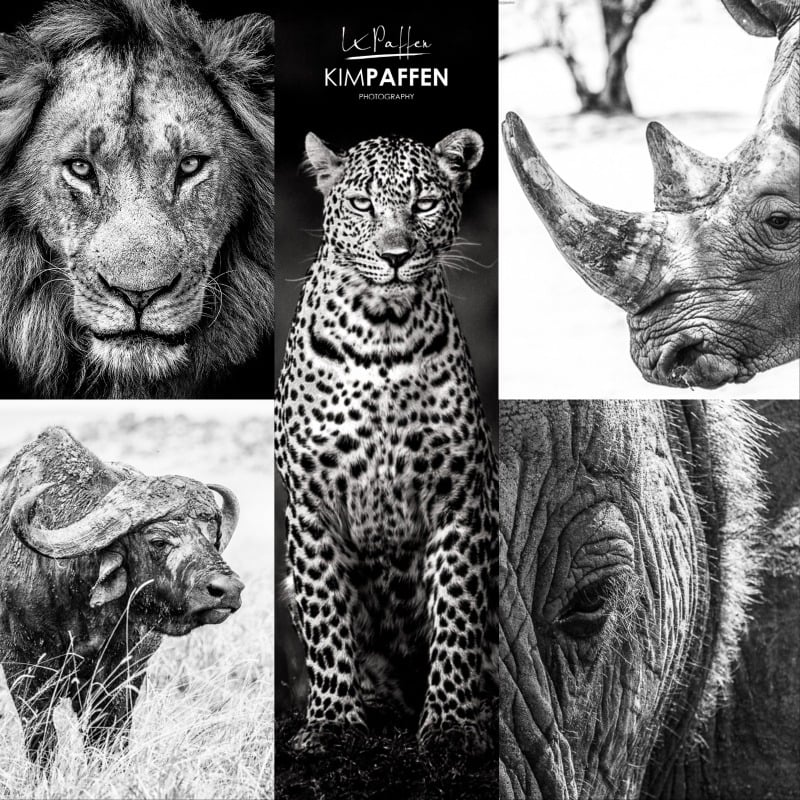
1. African Elephant: a gentle giant
The African savanna elephant is the largest land mammal in the world and can reach up to 3 meters in height and can weigh up to 7 tons. The African forest elephant is 3 feet shorter. Elephants communicate across a large distance at a very low frequency through their feet and the soil that cannot be heard by humans. Elephants live in a herd that is led by the 'matriarch' female. The elephant is threatened by ivory poachers for their tusks.
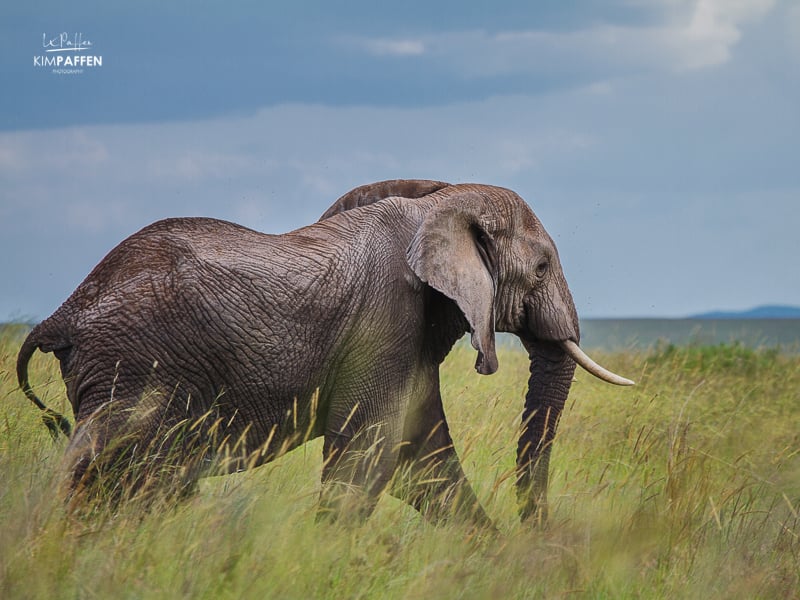
2. Rhino: most endangered species of the Big 5
The Rhinoceros is the most endangered species of the Big Five due to rhino poaching and illegal trade in rhino horns. There are two species of rhino in Africa: the White Rhino and the Black Rhino and five subspecies.
The names of the rhino don't have anything to do with color as both species are grey. The name of the 'white' rhino is a corruption of the Dutch word 'wijd' (wide), which refers to the wide mouth or square lip of the white rhino. A rhino can weigh up to 5000 pounds and its horns can grow up to 5 feet long. Rhinos have poor eyesight but excellent hearing and sense of smell.
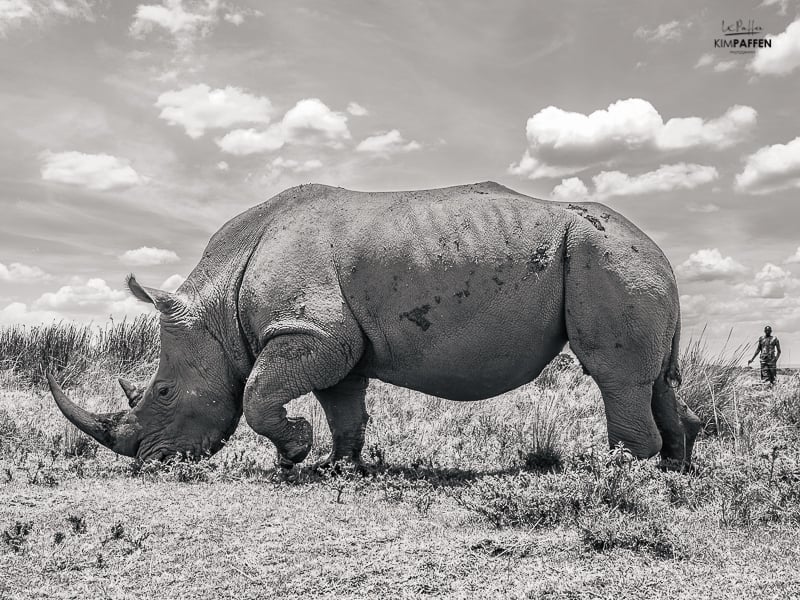
3. African Lion: courageous King of the jungle
An African lion is the largest predator on land. Preys of the lion include zebra, impala, giraffes, and other herbivores like wildebeest. A group of lions is called a pride and males are easily distinguished from females because of their large manes. The darker the lion's manes, the older he is.
A male lion is sometimes referred to as the king, but in reality, lions don't have a permanent social hierarchy. The dominant male in a lion pride can change at any time. The females hold the territory and stay with the pride in which they were born. They also do most of the hunting and take care of the cubs. Lions use their roar as a form of communication and can be heard up to 5 miles away.
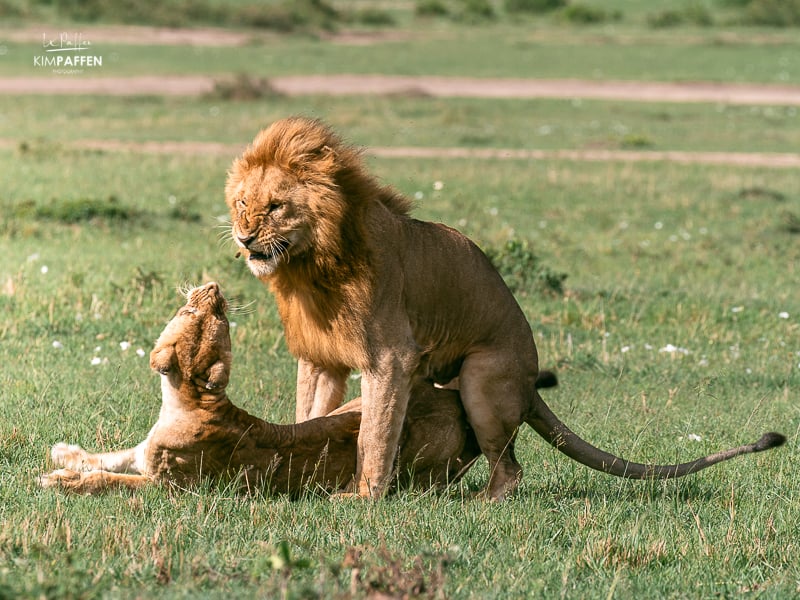
4. Leopard: sneaky and excellent tree climber
The African leopard is the most solitary and elusive animal of the big 5, staying hidden during the day. They are the least seen of the Big 5 and on most occasions found alone. The leopard is nocturnal and mainly hunts at night. Their kills include zebra and antelopes like Thompson Gazelle. The elusive leopards hide their prey in a tree to prevent lions and hyenas from stealing it. A lion and a leopard both belong to the African big cats, but they can't get along. A lion will kill a leopard if it has the chance. A leopard is also a good swimmer and occasionally eats fish.

5. Cape Buffalo: most dangerous to humans
The African buffalo is very territorial and protective and is probably the most dangerous animal of the big five to humans. If this cow-like animal feels threatened it can become very aggressive and charge with astonishing speed. Buffaloes are mostly found in groups and large herds and spend a lot of their time grazing. Both male and female buffaloes have horns, but the males' horns curve and come together in the center, forming a big bony plate called a boss.
The primary predator of the buffalo is the lion. A buffalo will try to protect and rescue another member of the herd and they have even been seen killing a lion after the lion had killed a member of the group. Although the African buffalo and water buffalo resemble each other, they are not closely related.
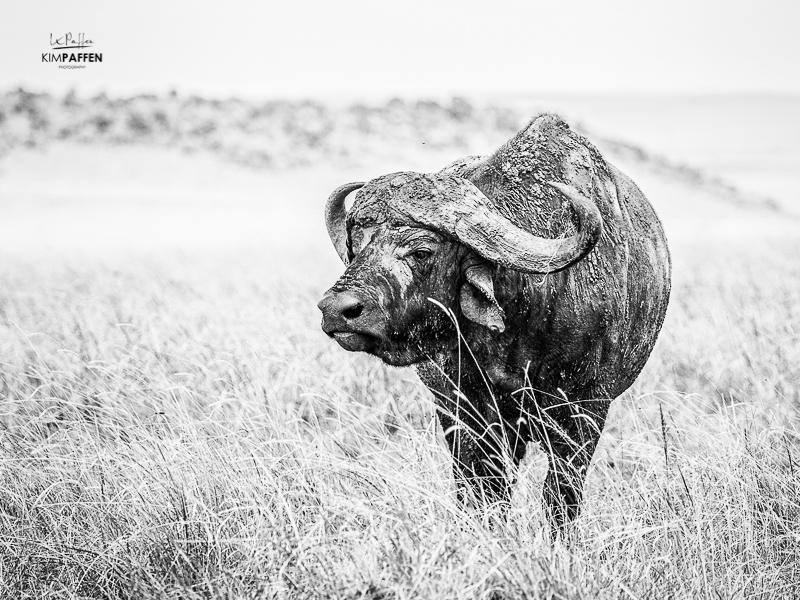
The Big 5 animals live on the African continent. You can find all of the Big 5 in Southern Africa and East Africa. The African countries where you can see the Big Five are:
- Democratic Republic of the Congo (DRC)
- South Africa
Not all of the above countries where the Big 5 live are ideal for a safari trip in terms of safety and existing numbers of the Big Five species.
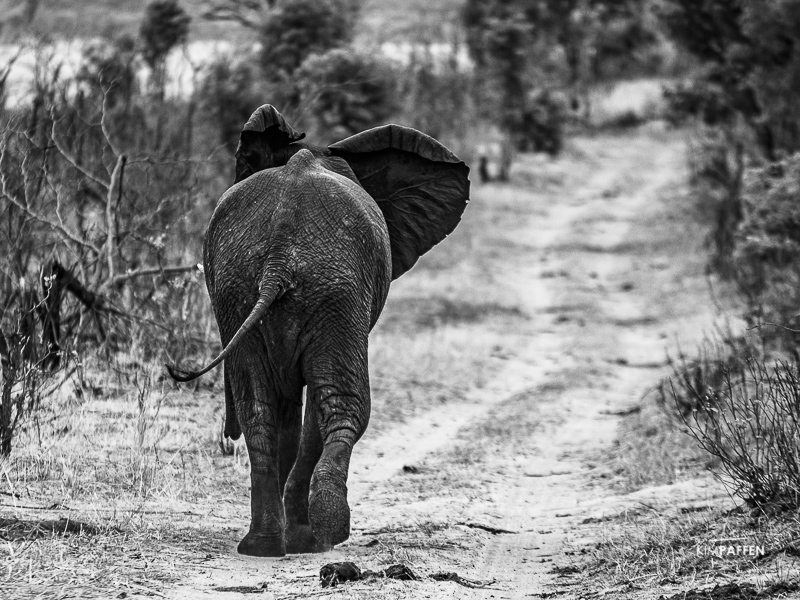
The best countries to see all the big five on safari are South Africa, Kenya, Tanzania, Botswana, Uganda, and Namibia.
However, in Namibia, you can't find all of the Big 5 in one place. In Etosha National Park you can only see 4 of the African Big Five. You can't find the buffalo there, but it's the best place in Africa to see the black rhino. They often concentrate around a water hole where tourists can sit to observe these critically endangered animals.
In Uganda, you can't see rhinos in the wild, but you have a chance of seeing all the Big 5 when you visit them up close at Ziwa Rhino Sanctuary where they roam freely but are protected by rangers 24/7. In Uganda, you can also see the endangered mountain Gorilla and our closest relative on a chimpanzee trekking or chimpanzee habituation.

South Africa is one of the most reliable Big Five safari destinations to spot all the Big 5 . South Africa even honored the importance of the Big 5 animals by putting each of the 5 animals on their bills.
The best chance of seeing the Big Five on a single safari or even on a single game drive is at the following places:
- Kruger National Park and the surrounding reserves, like Sabi Sand Game Reserve . Kruger is one of the best places to go for a safari in South Africa for both beginner safari travelers and seasoned wildlife viewers. Sabi Sand hosts luxurious safari lodges and shares an unfenced border with Kruger with an abundance of wildlife roaming around freely. It's also known for its high number of leopard sightings.
- Shamwari Private Game Reserve is a great place to find the Big 5 in South Africa. A beautiful high-end reserve with luxurious lodges and an exclusive feeling. You're often the only safari vehicle at an animal sighting. Shamwari is also well-known for its wildlife conservation initiatives, like the born-free Foundation.
- Ngorongoro Crater in Tanzania is a perfect place to find all of the Big Five in one day and you can combine your trip to the Ngorongoro Crater with for example the Serengeti which is famous for its wildlife sightings including the great migration of wildebeest and zebra.
- Maasai Mara National Park and the Mara Conservancies are also one of the best places to find the Big 5, although seeing rhinos roaming freely is a challenge. Some conservancies have a rhino sanctuary, but these rhinos are protected by rangers 24/7. An example is the Enonkishu Conservancy on the northern boundary of the Maasai Mara Conservancies. Another great place in Kenya to see rhinos is at Ol Pejeta Conservancy.
Of course, there are much more places and national parks to see the Big Five. Not all national parks have all of the Big Five and when they do have them, it can be harder to spot all of them on a single safari in Africa.
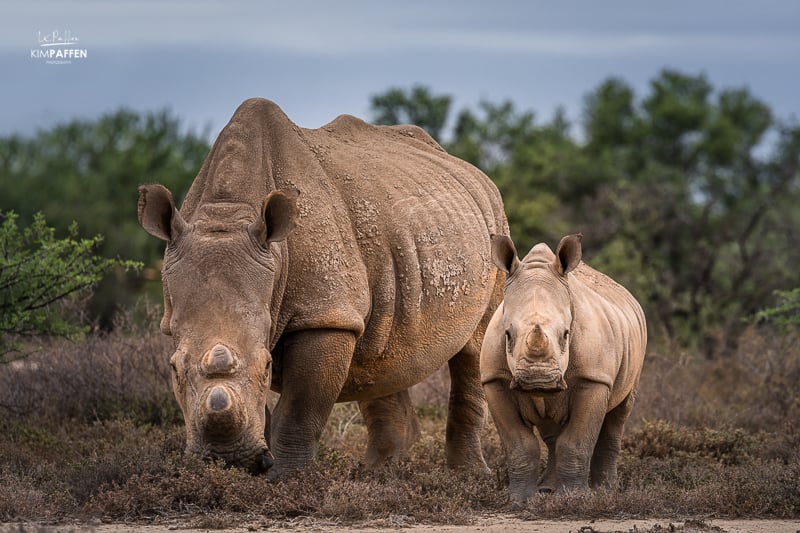
The high season for a safari in Africa is from July to October . It's the cooler dry winter which makes a Big 5 sighting easier because of the thin and dried-up vegetation. The lack of rain also means animals congregate around flowing rivers or larger lakes to drink. However, the shoulder seasons are also perfect to find the big 5 in Africa and it's less touristy.
Africa's Big Five are of great concern for wildlife conservationists due to trophy hunting, poaching, and habitat loss. Most of the Big 5 animals are listed as vulnerable or (critically) endangered species by the International Union for Conservation of Nature (IUCN). Hunting is sadly still allowed to some degree, but Africa now also has strict laws to protect and conserve many African animal species.
The black rhinoceros is classified as critically endangered and the southern white rhinoceros is near threatened. Mostly due to poaching because of the rhino horn. Two species of the African Big Cats , the African lion, and the African leopard are classified as vulnerable. The African savanna elephant is an endangered species, mainly because of the poaching crisis and habitat loss. The African buffalo is of the least concern of all the Big Five animals.
Contributing to wildlife conservation
The African Big 5 animals and other endangered species are widely protected in National Parks and government-run game reserves; partnering with the surrounding communities to reduce the human-wildlife conflict. Tourists contribute directly to big 5 wildlife conservation by going on safari in Africa and paying park fees.
As a nature and wildlife photographer, I also give back to wildlife conservation by donating 10% of each Fine Art Wildlife Photo Print sold in my webshop to the education of guides and rangers as a long-term goal to change the world and to protect our wildlife from extinction due to wildlife crimes and habitat loss. By buying a print in my webshop, you can make a difference too!
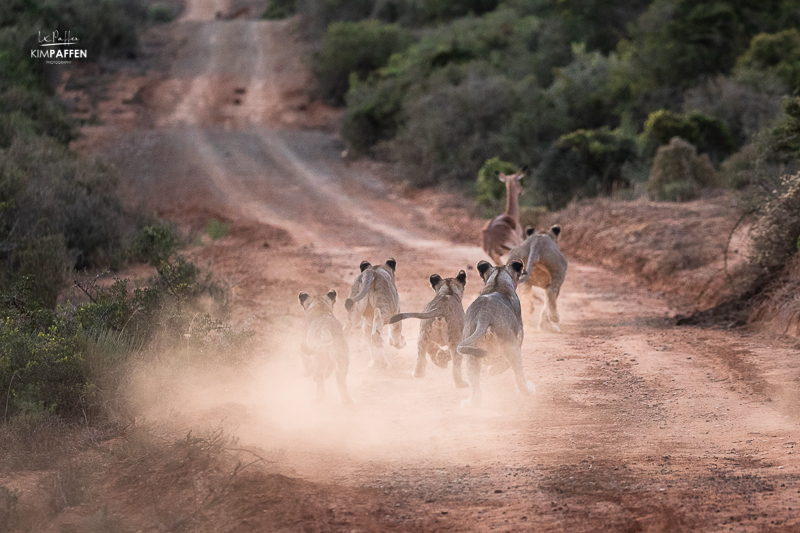
Apart from having the Big 5 in Africa, there are also other animal combinations formed that include 5 African animals. Africa also has the Shy Five and Little Five . It even named the Ugly Five , but that is very subjective.
Did you know I'm a qualified Field Guide (also known as a nature guide or safari guide )? I'm more than happy to take you on a photo safari to Africa with me where you will learn even more about the Big Five and all other flora and fauna. As a photographic tour leader and Dutch/English/German-speaking tour guide, I work closely together with local African tour operators and local drivers/guides. Get in touch to enquire about the possibilities.
I hope this article was helpful to learn more facts about the African Big 5 animals , including why they are called the Big Five, in what countries these Big 5 safari animals are found, and the best time of spotting them with a side note that there's more to Africa than spotting the Big Five.
Smaller creatures play an important role in the ecosystems as well. People who are going on a safari in Africa shouldn't be disappointed when they don't tick off the Big Five. Try to appreciate every single animal, big or small. Even trees, plants, and flowers. Every sighting is a gift of nature. Everything is connected and we should appreciate this more.
You would help me a lot by sharing this guide to the Big 5 in Africa on your social media or pinning it on Pinterest for later use.
Want to keep up to date with my travels? Follow me on Instagram @ourplanetinmylens. If you are inspired to go on a safari to Africa, you can find all of my writing about Africa and its countries in my Africa Travel Guide .
Pin the Guide about the Big 5 animals on Pinterest!
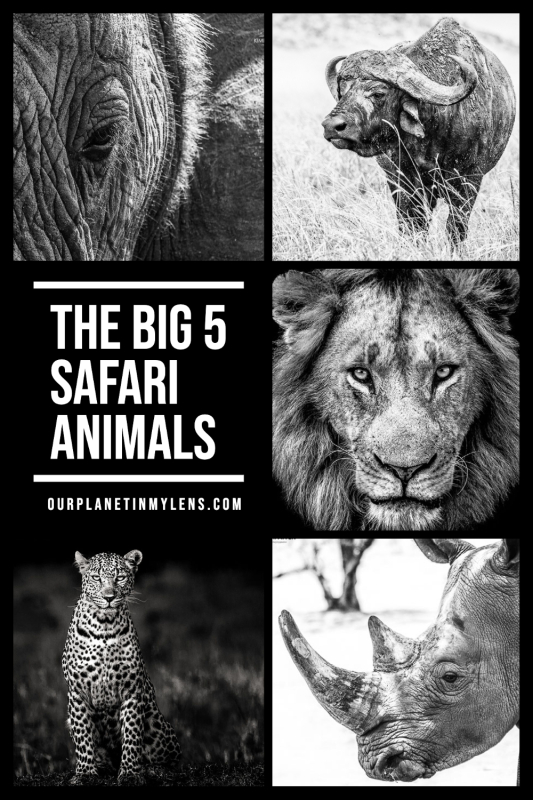
- 1x Each Month! A newsletter with free photography & travel tips to help you make the most out of your trip
- Be the first to know about giveaways, for instance, free ebooks and downloadable travel images
Yes, I want to receive the newsletter 1x p/month
- You are here:
Best Places To See the Big 5 on Safari in Africa
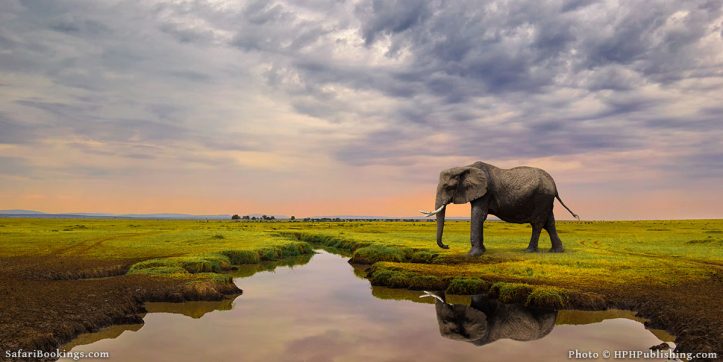
Ariadne is an Africa expert. She and her husband form a team who author many guidebooks to African countries.
Going on safari in Africa has become closely associated with seeing the Big Five. Have you ever wondered what that is all about and where you should go? The term ‘Big Five’ originated in the early days of game hunting. Lion, leopard, elephant, buffalo and rhino were the most dangerous animals to hunt and were therefore considered the most valuable trophies. Today, with most visitors armed with cameras, the Big Five are still perhaps the most exciting encounter on a safari. Below are some of the best places to see the Big Five in Africa.
9,600 African Safaris
1. Sabi Sand Game Reserve – South Africa
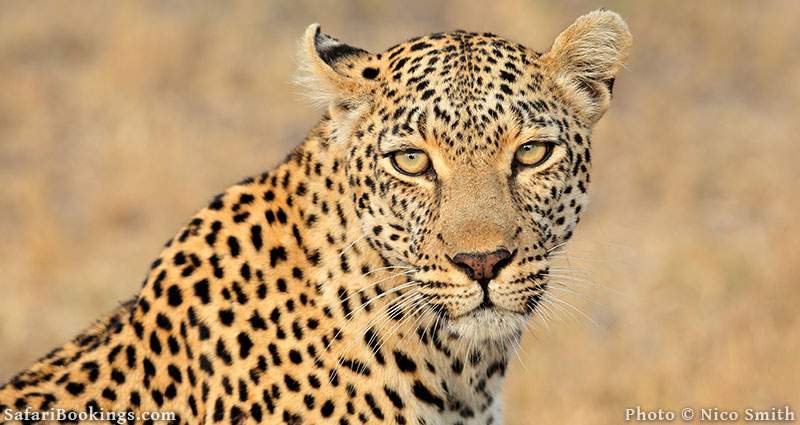
Spotting the Big Five doesn’t get easier than in Sabi Sand Game Reserve . This cluster of jointly managed private reserves has open borders with Kruger and forms part of the same ecosystem, but animals tend to be more relaxed. Furthermore, unlike in Kruger, guided drives in open vehicles are permitted to head off-road, which makes for fantastic close-up viewing. The real star of Sabi Sands is the leopard. Nowhere else is this usually shy creature so habituated. Most guests are treated to sightings of leopards as they go about their daily routine: a male patrolling or hunting, a female nursing cubs, possibly even a mating pair in action.
- When to visit Sabi Sands : There is no bad time to visit Sabi Sands, but wildlife viewing is best in the dry winter months from May to September.
- Where to stay: There are many lodges spread over the different reserves of Sabi Sand. All offer a similar experience inclusive of meals and activities. The standard of decor, service and guiding is superb. There are no camping or budget accommodations in Sabi Sands.
100 Sabi Sands Safaris
2. Ngorongoro Crater – Tanzania
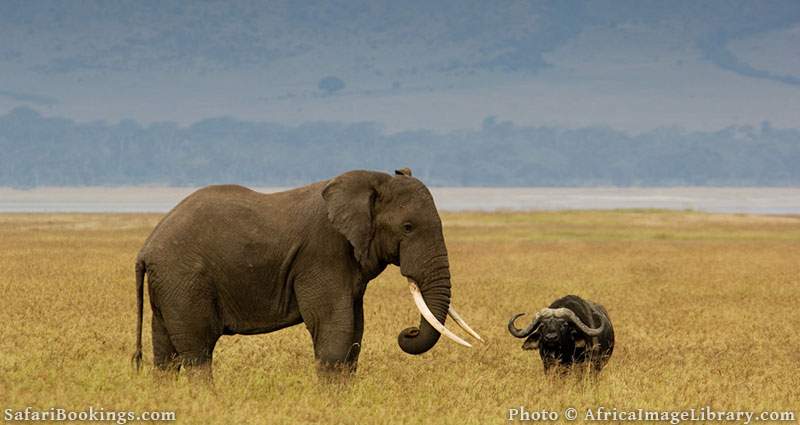
Ngorongoro Crater offers incredible wildlife viewing. Although animals can move in and out of the crater, climbing the steep caldera walls requires some effort, so much of the wildlife is resident inside. This includes a healthy population of black rhino. These shy creatures are rarely seen in East Africa, but the crater is one of the few places where they are easy to find. The other four members of the Big Five are prolific as well, although leopard sightings are hit-and-miss, and less likely inside the crater than on the forested rim. The good news is that these elusive cats are quite common in the Seronera area of Serengeti National Park, the next stop after Ngorongoro on most northern Tanzanian safari itineraries.
- When to visit Ngorongoro Crater : Wildlife viewing is always good in the crater, but marginally better in the Dry season when the grass is short and animals are easier to spot. The calving season of the wildebeest is from January to February and the best time to avoid the crowds is in the low season months, April and May.
- Where to stay: Several upmarket lodges are perched on the crater rim offering great views over the crater floor. There is a campsite on the rim as well, but be warned, it gets very cold here at night. Several lodges and hotels in the gateway town of Karatu are also used for visits to the crater. There are no accommodations within the crater, itself.
3,186 Ngorongoro Safaris
3. Masai Mara National Reserve – Kenya
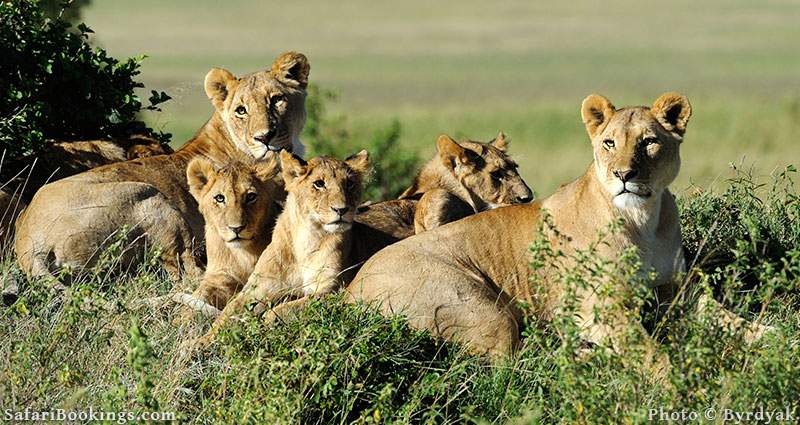
The Masai Mara is home to all of the Big Five but is most famous for big cats. You’ll be tripping over lions and cheetahs as they are remarkably common, and leopards are regularly seen too. Black rhinos are also present, but unless you’re fortunate enough to stay in the remote Mara Triangle in the far west, your chances of seeing one are slim. However, Lake Nakuru National Park, a popular stop-over en route to the Masai Mara, is home to both black and white rhino (but no elephants). White rhinos are commonly seen in small family groups grazing around the lake, especially from mid-morning and in the late afternoon.
- When to visit Masai Mara : Wildlife viewing is good throughout the year. To catch the wildebeest migration, you should aim to be here between late August and early October.
- Where to stay: There is no shortage of accommodations inside and just outside the reserve. All budgets and styles are catered for. There are several campsites as well.
1,302 Masai Mara Safaris
4. Kruger National Park – South Africa
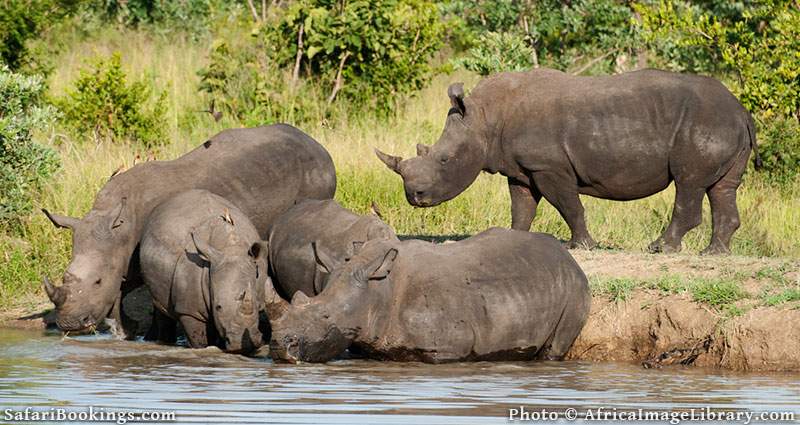
Whether you’re on a guided tour or self-driving, Kruger National Park is a great choice for a Big Five safari. The park is the size of a small country, and the wide variety of habitats it protects is reflected by the varied wildlife. Identifying all the different antelope species in Kruger can be an enjoyable challenge. In terms of the Big Five, lion, buffalo and elephant are easily found in southern Kruger, which is also one of the best places to see white rhino. With time on your hands and a bit of luck, you might spot a leopard too. Make sure to be out and about at dawn and dusk to increase your chances of seeing this shy cat which is active at night.
- When to visit Kruger : Wildlife viewing in Kruger is best from May to September. These are the dry winter months when animals don’t stray far from waterholes and rivers. During the wet summer months, the bush gets very thick and animals are more difficult to spot.
- Where to stay: Well-equipped, basic rest camps offering campsites and huts can be found throughout Kruger. Several private concessions within the park offer a luxurious and more exclusive alternative.
446 Kruger Safaris
5. Madikwe Game Reserve – South Africa
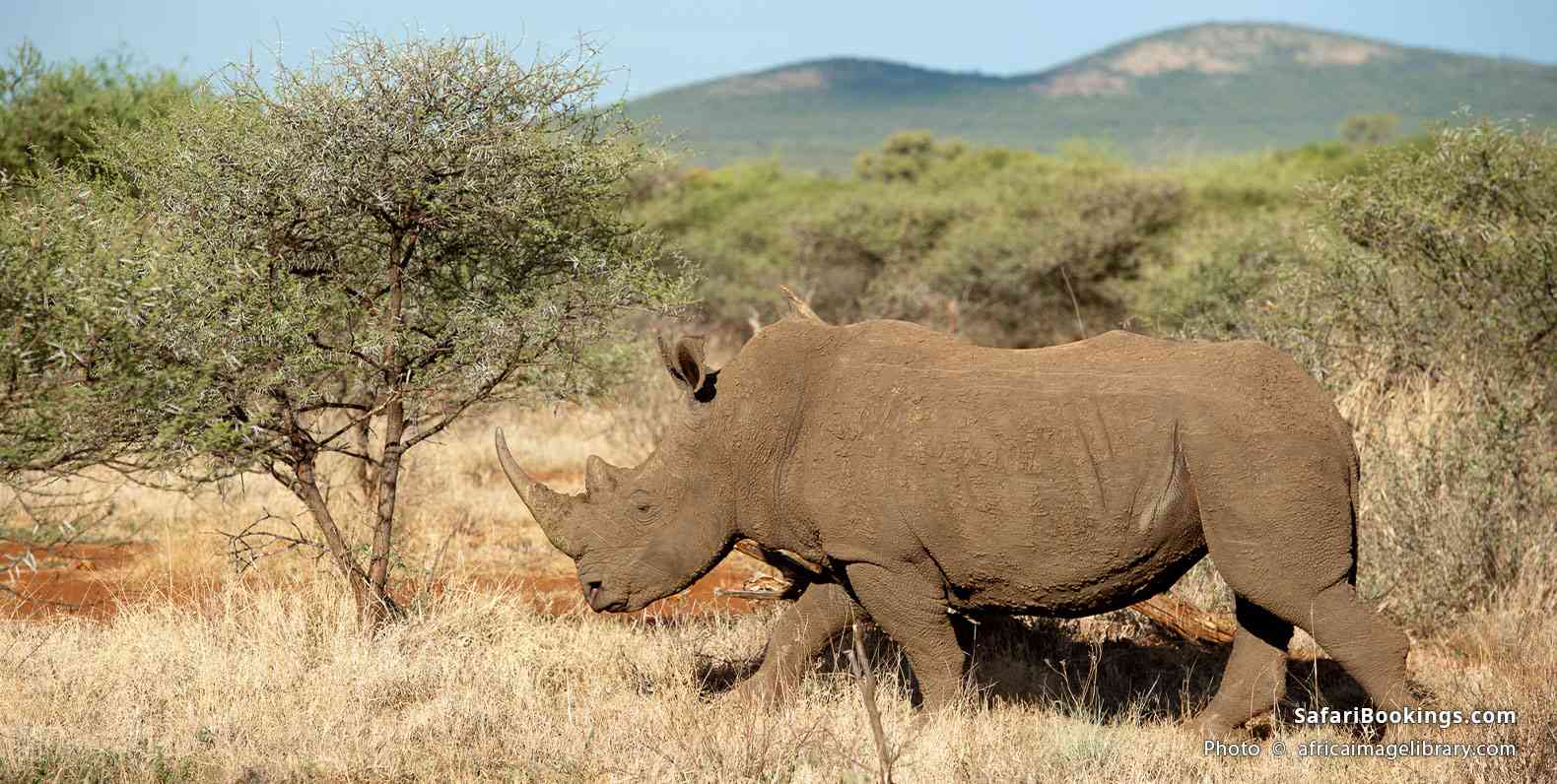
Madikwe is arguably the top African safari pick for those who want a good chance of spotting most of the Big Five in a malaria-free destination. Forged from formerly unproductive ranchland in 1991, this exceptional park protects a 750km² /290mi² tract of semi-arid savannah in North West province, some four to five hours’ drive from Johannesburg. Shortly after being created, it was stocked with 8,000 individual animals comprising 28 species, including all the Big Five. Today, you’re very likely to see lion, elephant and white rhino over the course of a few days in Madikwe, and there’s a fair chance of buffalo and leopard. Madikwe is also known as one of the best places to look for the endangered African wild dog, while other wildlife includes cheetah, giraffe, zebra and a wide variety of antelope. An unusual feature of Madikwe is that it is a state-owned property that functions more like a private reserve insofar as it is closed to self-drive safaris and day visits.
- When to visit Madikwe : There is no bad time to visit Madikwe, as the expert guides are good at finding animals at any time of year. However, optimum wildlife viewing is over the dry winter months of May to September, when animals stick close to perennial water sources.
- Where to stay: Madikwe is serviced by several small upmarket lodges that specialize in all-inclusive packages with guided game drives taking place in open 4x4s. There are no budget accommodations or camping facilities.
22 Madikwe Safaris
6. Okavango Delta – Botswana

The Okavango is one of Africa’s most iconic wildlife destinations. The Delta is home to all of the Big Five, although rhino (both black and white) can be hard to find; Moremi Game Reserve offers the best chance, or visit Khama Rhino Sanctuary, a half-day’s drive away as an add-on. Buffalo and elephant thrive in the wetlands, and you should see some big cats as well. The most productive activity for spotting typical safari animals, including the Big Five, is a game drive. But you should put aside time to do a guided walk and for exploring the Delta’s channels by mokoro (traditional dugout canoe). Gliding silently through waterlilies, dodging the odd hippo and scanning the shore for animals coming to drink, is an experience that will stay with you long after your trip.
- When to visit Okavango : The best time for wildlife viewing is from July to October.
- Where to stay: There are dozens of luxury lodges in the Okavango. Camping is popular too.
218 Okavango Delta Tours
7. Ol Pejeta Conservancy – Kenya

High on the Laikipia Plateau, just north of Kenya’s Central Highlands, Ol Pejeta Conservancy is a fine place to see the Big Five just a few hours north of Nairobi. Seeing lions on a guided game drive is always possible, but the conservancy also offers a fine lion-tracking excursion, which really increases your chances. Rhinos are also commonly seen, both roaming free out on the grasslands, and in the enclosures for the last two remaining northern white rhinos on the planet. Leopards inhabit the dense thickets and riverine woodlands, while elephants and buffalo are also common. Some of the nearby private and community conservancies, including Lewa Wildlife Conservancy, are more exclusive, but are also known for their Big Five possibilities.
- When to visit Ol Pejeta : The June to September Dry season promises the best weather for visiting Ol Pejeta with clear skies and mild temperatures the norm. It’s usually dry from December to February, but hotter and more humid. The best birding is from November to April, when migratory species are present.
- Where to stay: Ol Pejeta Conservancy has a good range of lodges and tented camps, as well as a campsite for budget travelers. Unlike most other Laikipia conservancies, you don’t need to be staying overnight to visit Ol Pejeta.
77 Ol Pejeta Safaris
8. Akagera National Park – Rwanda
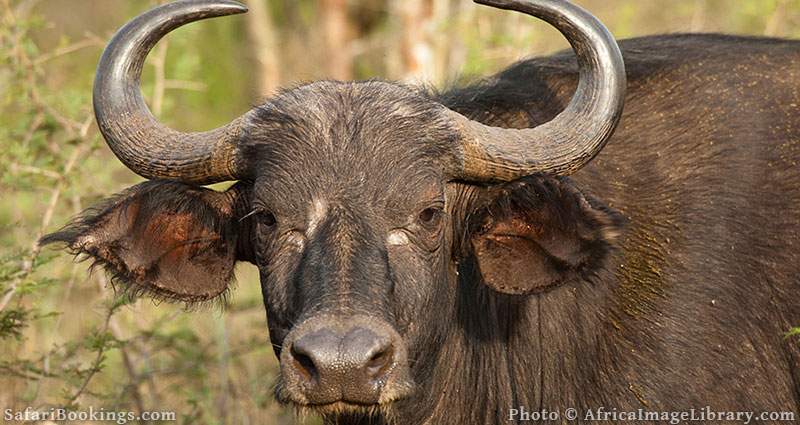
While Rwanda is well known for its mountain gorillas, it is also home to the Big Five and many other savannah-dwelling animals. The place to go on a classic safari in Rwanda is Akagera National Park . Wildlife here was heavily depleted by warfare and poaching, but since 2010 it has made an impressive comeback. The reintroduction of black rhinos and lions in 2017, followed by white rhinos in 2021, means that Akagera offers a truly off-the-beaten-track opportunity to see the Big Five in Africa.
- When to visit Akagera : The Dry season, from June to September, is the best time to visit.
- Where to stay: There is a luxury tented camp, a seasonal bush camp and a mid-range lodge inside the park. There are also several campsites without facilities available to self-sufficient travelers.
101 Akagera Safaris
9. Murchison Falls National Park – Uganda

Murchison Falls National Park is as much worth visiting for its spectacular scenery as for its wildlife. It is bisected by the Victoria Nile River. A boat trip to the base of the waterfall for which the park is named is not to be missed. The river is home to hundreds of hippos and crocodiles and, in the afternoon, you’re likely to see buffalo and elephants on the shore. Murchison Falls is not a complete Big Five destination as there are no rhinos, but many visitors stop in at Ziwa Rhino Sanctuary en route for an exciting rhino tracking experience.
- When to visit Murchison Falls : December to February is best for general wildlife viewing but be prepared for hot weather at that time.
- Where to stay: There is a good choice of upmarket and mid-range lodges inside the park and budget accommodations are available just outside. There are several campsites too.
392 Murchison Falls Safaris
10. Phinda Game Reserve – South Africa
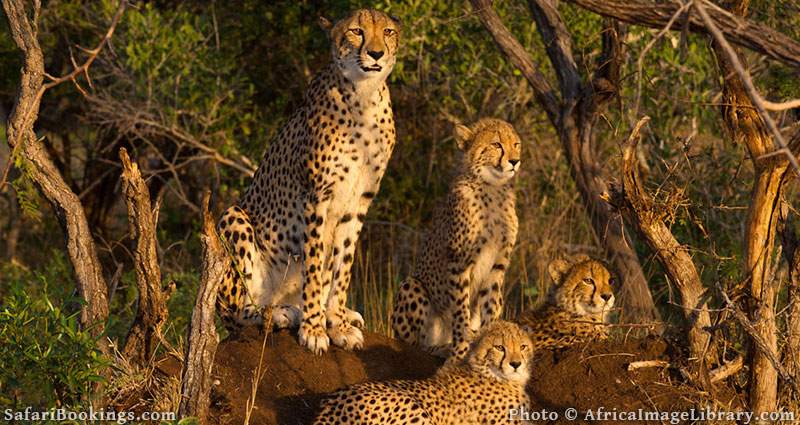
Phinda is one of South Africa’s top private Big Five game reserves. You have a choice of four stunning accommodations spread out over the reserve’s different habitats: Rock, Mountain, Forest and Vlei (wetland) Lodge. The guiding is superb and you’ll easily see four of the Big Five (lion, elephant, buffalo and white rhino) as well as some Zululand specials, such as the graceful nyala and the shy red duiker. Although there are plenty of leopards around, you’d be lucky to see one. As compensation, Phinda’s flagship species is the cheetah and sightings of this graceful big cat tend to be incredible.
- When to visit Phinda : Phinda’s wildlife viewing is always great but animals are slightly easier to find in the Dry season from May to September.
- Where to stay: There are four luxury lodges in Phinda.
Phinda Safaris
11. Majete Wildlife Reserve – Malawi
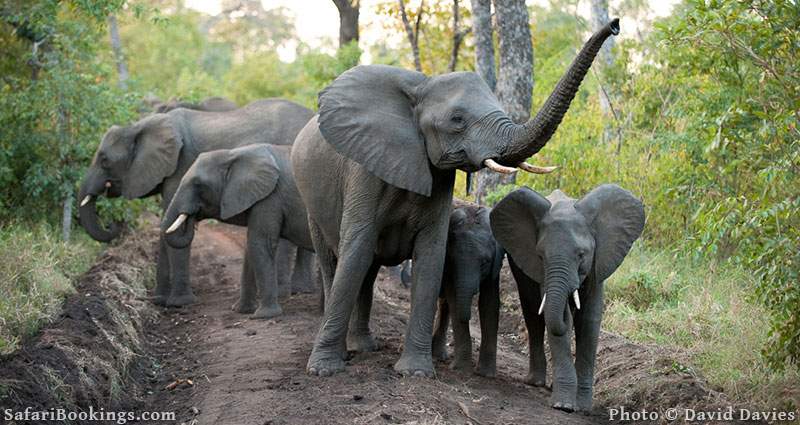
Majete Wildlife Reserve is one of Africa’s modern environmental success stories. Prior to 2003, the park was almost completely hunted out. Since then, under the management of African Parks, nearly 5,000 individual animals, including all of the Big Five, have been reintroduced. Elephants have bred so successfully that a surplus of 200 individuals were relocated to Nkhotakota Wildlife Reserve. Although sightings require a bit of patience, Majete offers a totally unspoiled experience, far away from the crowds. A ‘behind the scenes’ tour, offering insight into what it takes to run a Big Five reserve, is recommended.
- When to visit Majete : You can visit anytime, but July to October is best for wildlife viewing.
- Where to stay: There are two mid-range lodges to choose from (one inside and one just outside the game reserve). Top of the range is an exclusive luxury lodge that operates in its own private concession. Campers are taken care of in a well-equipped community campsite.
Majete Safaris
Want To Go on an African Safari?
Click on the button below to compare African safaris offered by top-rated tour operators.
About SafariBookings
SafariBookings is the largest online marketplace for African safari tours. Easily compare offers from top-rated tour operators. Make decisions like a pro by using our 104,520 reviews and 223 destination guides. More About Us
Safaris by Type
- Luxury Safaris
- Budget Safaris
- Gorilla Trekking
- Chimp Trekking
- Family Safaris
- Private Safaris
- Group Safaris
- Photo Safaris
- Overland Tours
- Camping Safaris
- Fly-in Safaris
- Walking Safaris
- Birding Safaris
- Self-drive Safaris
- Canoe Safaris
Most Popular Blog Posts
- Best Time for African Safari
- Best Safari in South Africa
- Family Safari in South Africa
- African Safari Tips
- Game Reserves Near Cape Town
- What to Pack for a Safari
- Best African Safari Parks
- Top 5 Best African Honeymoon Safaris
- Top 5 Best Tanzania Family Safaris
- Best Places to See Cheetahs in Africa
- How Much Does an African Safari Cost?
- Best Places To Visit In Africa in 2024
Blog Categories
African safari tours.

9-Day Luxury Tailor-Made Tanzania Wildlife Safari
$7,890 to $11,991 pp (USD)
Tanzania: Private tour Luxury Lodge & Tented Camp
You Visit: Arusha (Start) , Tarangire NP, Ngorongoro Crater, Northern Serengeti NP, Arusha (End)

4.9 /5 – 149 Reviews

7-Day Black Rhino Tracking Luxury Safari
$3,080 to $3,520 pp (USD)
You Visit: Arusha (Start) , Tarangire NP, Serengeti NP, Ngorongoro Crater, Arusha (End)
Serengeti Wakanda Tours and Safaris
5.0 /5 – 475 Reviews

8-Day Exceptional Luxury Safari-Magical Kenya Fairyland
$3,212 to $3,850 pp (USD)
Kenya: Private tour Luxury Lodge & Tented Camp
You Visit: Nairobi (Start) , Amboseli NP, Lake Naivasha (Naivasha) , Lake Nakuru NP, Masai Mara NR, Nairobi (End)
Apodiformes Adventures
4.8 /5 – 175 Reviews
SAFARIS FOR AFRICA
Need help?
- Sep 30, 2022
Everything you need to know about Africa’s Big 5 animals
Updated: Nov 3, 2022
Travelers who are planning to go on a safari in Africa may have come across the term ‘Big Five’ while doing their research; this refers to five African animal species, namely the Buffalo, Elephant, Lion, Leopard and Rhino.
When selecting where to go on a safari, you will notice that game reserves, or lodges and safari camps, will state whether they offer a Big Five Safari; if so, this means that there is the possibility of spotting these five animals in the wild.
Why are they called the Big Five?
Many moons ago, hunters in Africa dubbed the five most dangerous animals to hunt on foot as ‘The Big Five.’ Although most safaris do not offer hunting activities anymore, the term ‘Big Five’ is still used in the tourism industry today and it is a phrase that has become widely recognised around the globe. This is because seeing a leopard dangling from a tree, a rhino and her calf sauntering past, or being three feet away from the majestic king of the jungle with not a single sound but the beating of your own heart, is a privilege second to none. Viewing these animals in the wild is such an exhilarating experience that may be difficult to grasp until it is your safari vehicle that is in the way of a large elephant bull flapping his ears and thrusting his tusks!
Africa's Big 5
The african elephant.

The African elephant is the largest animal roaming the earth and their most recognisable features are their long trunks, large ears, and fearsome tusks. Unfortunately, it is the latter attribute that has contributed to the massive decline of this species because of poachers who are driven by the illegal ivory trade. Another threat to their survival is a growing human population. As our numbers increase, the need for more land increases, which in turn decreases the land for the elephants. A lack of resources leads to elephants destroying agricultural land, which puts them at risk from human conflict. A huge part of African elephant conservation is collaborating with local communities to assist them with effectively managing conflict with the species.
Without these threats, elephants can live up to 70 years in the wild in multi-generational herds. These herds are led by a matriarch and made up of other females and their young. Pregnancy can last up to 22 months with elephants usually reproducing one calf every 3 to 4 years. Males and young bulls roam the land on their own or form small groups known as bachelor herds.
Elephants are herbivores and can be seen eating roots and fruits, grasses and bark, which they consume in abundance! They spend most of their day covering large distances while feasting along the way. They also love water so consider yourself lucky if you stumble across a herd bathing at a waterhole!
Travel tip : One of the best places to view African elephants is in Chobe National Park in Botswana, suitably referred to as ‘The Land of the Giants.’ This destination is home to Africa’s largest elephant population with individual herds reaching into the hundreds. Chobe, along with the Okavango Delta (also located in Botswana), are two fantastic safari destinations in Africa. If you are thinking of visiting Botswana, the best time to travel would be between May and October as the rains have stopped and water is abundant, creating excellent conditions for game viewing.
The African Leopard

The most elusive of the Big Five, the African leopard is considered the holy grail of safari sightings and you will not be disappointed. This cat has an exquisite coat that is yellowish-brown in colour, sometimes appearing gold, with black spots also known as rosettes decorated across its body. Milky green eyes are often captured behind a camera lens with a piercing stare that will send chills down your spine!
These are nocturnal animals, solitary by nature, and incredibly adaptable to different environments (location and habitat can influence the size and colour of a leopard). Males are noticeably larger than females, however it is rare that you will have the opportunity to compare the two genders unless territories have intersected (with males overlapping territories with females), or if they are mating.
A leopard is pregnant for approximately three and a half months, giving birth to between 1 and 3 cubs at a time. Generally, only 50% of the litter will survive, and those that do can live for about 15 years in the wild.
Sighting of leopards often occur in trees as they are known to hoist their meal into the treetops away from other predators or scavengers, such as hyena. Their diet consists of small to medium size prey, which can be anything from a guinea fowl to a small antelope. The strength required to drag an impala up a tree is immense and shows just how strong these animals are!
Like most cats, leopards communicate through scent, body language and behavior such as the marking of trees. With scent glands on their cheeks, they rub their faces on branches or pathways to make it clear whose territory it is, and they also communicate their mood with their tail. Growling, hissing or a rasping roar may be heard when leopards are communicating between their own or other species.
Unfortunately, leopards are listed as vulnerable on the global IUCN Red list due to habitat loss, trophy hunting and conflict with humans.
Travel Tip: One of the best places to see the African leopard is in the Sabi Sand Game Reserve in South Africa, where highly skilled guides will pull out all of their knowledge and expertise to get those close-up encounters of this extraordinary wild cat of Africa.
The African Buffalo

If you have seen a buffalo in person, then you will understand why it is part of the Big Five. With a helmet of horns perched on their heads, buffalos can weigh between 300 to 835 kilograms and are about one to two meters in height. It is no surprise that the hunter once considered this to be a formidable opponent in the African bush, and the same goes for today’s travelers. If you happen to find yourself on a walking safari, coming across a herd of buffalo along the way is not something you take lightly, especially if they are in close range.
The Cape Buffalo is the most common out of the four subspecies and are often seen in large herds, predominantly made up of females and young, with males breaking away to form bachelor herds. Living in large herds protects the buffalo from predators, such as lions, who will single out an individual as a meal for their pride. This species can live 11 to 22 years in the wild and the females will reproduce every two years about. Considering they spend most of their time grazing, birthing season typically occurs after the rainy season when there is an abundance of grass.
Travel Tip: One of the best places to see buffalo is in the Kruger National Park where you will come across very large herds.

The African Rhino

The white and black rhino are two subspecies of the African rhino, with the former recognisable by its square lip and the latter a hooked lip. Both species have two horns and are just as prehistoric looking as each other! Despite a long lifespan of 35 to 40 years in the wild, few make it as long as this because they are being killed for their horns.
In Asia, it is believed that rhino horn, which is made of keratin, has the ability to cure cancer, hangovers and even impotence. This has resulted in a massacre of this species and the war is still being fought today to protect rhinos from the threat of extinction. Sadly, it has become a common sight finding a young calf standing alongside its dead mother who has had her face severed. With 16 months in gestation, the turn around time is just not long enough for the species to revive itself and that is why rhino conservation is at the forefront of African wildlife protection.
Travel tip: Hluhluwe Imfolozi Game Reserve is the oldest proclaimed game reserve in Africa, and the very place that saved the white rhino from the brink of extinction. Today, it is home to one of the largest populations of white rhino in the world. Visiting this reserve in Zululand, South Africa is a very special experience as it is the birthplace of white rhino conservation. (Our article ‘Operation Rhino’ will provide more information on the history of this reserve)
The African Lion

The mighty ‘King of the Jungle’ is in a league of its own and definitely deserves a spot on Africa’s Big Five list being the largest carnivore in Africa! This is a highly sociable species that live in prides that can range from anything between 10 and 40 pride members, which are made up of females, their young, and dominant males. The males are easily distinguishable by their manes that are regally wrapped around their head and chest, and their iconic roar will evoke and emotion that will reverberate through your soul!
Ironically these fearsome beasts can sleep up to twenty hours a day and are more active at night when they are known to hunt.
Lions will take down medium to large prey, and this can be anything from a young warthog to a large buffalo. Although they have very few threats of their own in the wild, and as with most of the Big Five, human-wildlife conflict and habitat loss have had them listed as Vulnerable on the IUCN Red List.
Travel tip: The Timbavati region in South Africa, which borders the Kruger National Park, is one of the only places in the world where you can still see white lions in the wild. Private reserves will generally have smaller numbers of lions than places such as the Kruger National Park where exceptionally large lion prides are sighted.
How much does a safari cost to see the Big 5 in Africa?
Going on a Big Five Safari in Africa will vary in cost depending on which location or country you are visiting. The most affordable option would be South Africa as the Rand to Dollar, Pound or Euro exchange rate is excellent and you get a lot for your money. Please click on the link for more information on the cost of a budget, middle-range and luxury safari in South Africa .
Bucket-list safari destinations such as Botswana and Tanzania will work out to be more costly, especially around the migration period. Etosha National Park, one of the largest national parks in Africa, situated in Namibia also offers excellent value for money with the Namibian Dollar being equivalent to the Rand.
For a quote and itinerary on your chosen safari destination please email us at [email protected]
References:
"African Elephant" World Wildlife Fund, Retrieved from African Elephant | Species | WWF (worldwildlife.org)
"Africa Elephant" Kruger Park, Retrieved from African Elephant - Kruger National Park - South Africa (krugerpark.co.za)
"African Leopard" South African National Biodiversity Institute, Retrieved from African leopard - SANBI
(sanbi.org)
"African Buffalo" African Wildlife Foundation, Retrieved from African Buffalo | African Wildlife Foundation (awf.org)
"Rhinoceros" African Wildlife Foundation, Retrieved from Rhinoceros | African Wildlife Foundation (awf.org)
"African Lion" Kruger Park, Retrieved from Lion - Leo Panthera - African Lion (krugerpark.co.za)
Recent Posts
Winter activities to do in South Africa
Things to do in Franschhoek
Visit Boulders Beach
Big 5 Safari
The magic of the big 5 safari in africa.
Experience the thrill and majesty of Africa's wildlife with Rhino Africa's premier Big 5 safaris. The Big 5 include the elephant, lion, leopard, African buffalo, and the rhino. They stand as a symbol of our rich fauna and seeing these magnificent creatures in their natural habitat is a highlight for any wildlife enthusiast.
Choosing the Perfect Big 5 Safari Destination
Africa is home to numerous game reserves and national parks that offer exceptional Big 5 sightings. Some of the best Big 5 safari destinations include South Africa's Kruger National Park , Tanzania's Serengeti National Park , Botswana's Chobe National Park , and Kenya's Maasai Mara National Reserve .
Each destination offers a unique safari experience and houses a diverse range of ecosystems as well as wildlife beyond the Big 5.
Experiencing the Big 5 with Rhino Africa
At Rhino Africa, our Big 5 safaris are about more than just ticking all five animals off your wildlife checklist. We aim to provide an immersive and educational wildlife experience , where you not only see these iconic creatures but also understand their behaviour, habitat, and conservation challenges.
Tailor-Made Itineraries for Your Big 5 Safari
Just like every traveller is unique, so should their safari experience be. Our Travel Experts will help you curate a Big 5 safari itinerary that matches your preferences.
Whether you're a photographer keen on capturing these magnificent creatures, a family on a vacation, or a couple on a romantic getaway, we've got you covered.
Luxury Accommodations: Perfect End to a Perfect Day
After a day filled with unforgettable wildlife sightings, retire to our carefully selected luxury lodges and camps .
Located in the heart of the wilderness, these accommodations offer top-notch facilities, exquisite cuisine, and spellbinding views of the African landscapes, adding an extra layer of luxury to your Big 5 safari.
Responsible Tourism: Safeguarding Africa's Treasures
As we delight in the awe-inspiring beauty of Africa's wildlife, it's crucial to remember our responsibility towards their conservation.
Our Big 5 safaris follow the principles of responsible tourism, ensuring the welfare of the wildlife and contributing to local communities. And by travelling with Rhino Africa, you leave your lasting legacy in Africa by empowering us to continue making a difference !
Book Your Dream Big 5 Safari with Rhino Africa
To see Africa's Big 5 in real life is an experience that stays with you forever. So, what are you waiting for? Contact our Rhino Africa Travel Experts today to plan your best Big 5 safari in Africa.
With our expert first-hand knowledge, personalised service, and passion for Africa, we'll ensure your safari is an unforgettable adventure. Let’s start planning !
How it works
- 1 Describe your dream trip
- 2 A Travel Expert will help curate your experience
- 3 Confirm & start packing
Let's plan your trip
Enquire now and a Travel Expert will get back to you within 24 hours.
Ready to start your journey?
ZA Number: +27 21 469 2600
Why book with us.

Big Five African Safaris
Many travelers to Africa wish to see the ‘Big 5,’ and rightfully so. These are some of the continent’s most iconic animals – lion, elephant, leopard, rhino, and buffalo – and the chance to see them in their natural habitats is what many imagine an African safari to be. It’s important to work with an expert to plan your Big 5 safari, as they aren’t present in all African countries, have seasonal movement and other habitat factors. We know where to send you and how best to position you to see these incredible animals.
Contact a Journey Specialist to get your questions answered and to begin planning your custom Big 5 Safari. Call us at 303-778-1089 .
Want to know more about what goes into planning a Big 5 safari? Take a look at our Planning Guide .
4-Day Safari to South Africa’s Top Wildlife Reserve
13-day safari to the best game parks in east africa, 8-day exclusive safari to tanzania’s northern circuit, 11-day luxury victoria falls, chobe & okavango delta safari, 9-day luxury safari to cape town and singita’s private concession in kruger np, 9-day safari to tarangire, ngorongoro crater, & serengeti, 12-day big 5 & gorilla safari and cultural tour, 8-day safari to chobe national park & okavango delta, 12-day big game and gorilla safari through kenya and uganda, 9-day wildlife & cultural safari offering fun for all, 8-day drive/fly safari designed for families with children, 7-day small group safari to ngorongoro, serengeti and more, 7-day small group safari to lake nakuru and masai mara, 4-day nature hike from empakai crater to lake natron, 10-day drive/fly small group safari to tanzania's top parks, 10-day drive/fly small group safari to kenya’s top parks, 12-day independent tour to cape town, winelands, garden route & safari, big 5 safaris trip ideas.
botswana luxury safari
best of kenya and tanzania
kenya unforgettable
south africa kruger safari
tanzania deluxe tented safari
kenya and tanzania group safari
best of southern africa
kenya luxury safari
tanzania luxury safari
botswana deluxe safari
botswana and victoria falls highlights
south africa luxury safari
tanzania migration safari
south africa highlights
kenya deluxe safari
rwanda and tanzania highlights
botswana highlights
best of east africa
south africa deluxe safari
tanzania family safari
kenya family safari
tanzania group safari
kenya group safari
zambia deluxe
tanzania adventure trek
kenya classic safari
tanzania sky safari
kenya sky safari
south africa active adventure
south africa honeymoon safari
south africa private villa safari
best of namibia
Big 5 Safari Features
Great for Photography
Expert Guiding
Iconic Safari Experience
More Reading
Traveler’s corner: exploring east africa’s wonders, malaria-free safari options, traveler’s corner: moms and daughter safari, top 3 destinations for your first safari, traveler’s corner: africa’s nature & cultures, what does a safari cost in 2024, desert vs delta – where to travel in botswana, what do safari guides do, contact a journey specialist, let our journey specialists help create your trip of a lifetime.
safari experts, since 1991
See how we earn 5 stars
Big 5 safaris
Safari experiences that you will not find with any other travel company. We know Africa best and will get you to the right place & time to enjoy the greatest shows on Earth!
Go on a Big 5 safari
Seeing lions, leopards, elephants, Cape buffalos & black or white rhinos is always a special experience, and many destinations offer the opportunity to tick the Big 5 off your list with ease. However, experienced safari travellers also tend to focus on other species such as cheetahs, wild dogs and pangolins and on experienced-based safaris such as animal migrations, bird-watching, cultural learnings, spending time in remote wilderness areas and rewilding projects.
Scroll past the safari packages below to find out EVERYTHING YOU NEED TO KNOW about Big 5 safaris.
The safaris below are to areas that host the Big 5
Everything you need to know about big 5 safaris.
Few sounds are as evocative and exhilarating as a lion roaring his challenge into the African night, triggering in us all a primordial reaction of fear and awe. Lions are essential players in Africa's wild spaces, ruthlessly executing the role of an apex predator, helping maintain biodiversity and ecosystems, which change fundamentally when lions are removed from them. READ MORE about lions here .
Breathtakingly beautiful, charismatic, powerful, and mysterious, leopards are the picture of perfection. Their self-contained grace and nimble frames belie an extraordinary explosive strength and speed when needed. Those who have spent time with leopards will tell you that every leopard sighting is unique – defined by the personality of the leopard itself. The only truly predictable aspect of leopard behaviour is its unpredictability. READ MORE about leopards here.
The African elephant is the largest land mammal in the world and one of nature’s great ecosystem engineers, contributing to maintaining the balance between wooded and grass ecosystems. Their beneficial impact on biodiversity is significant, and many other species depend on elephants for their survival - making them a key species in Africa. Elephants are fascinating and endearing - time spent with them nurtures your spiritual health and well-being. READ 17 elephant facts you need to know.
The African (Cape) buffalo has earned itself a reputation, particularly for the cantankerous old bulls, otherwise known as dagga boys or kakuli , that spend their time wallowing in pans or hanging around in dense reedbeds along Africa’s rivers. Immense and powerful, the buffalo should not be underestimated - as many lions have discovered. Don’t be fooled if your only experience of them is from the safety of a game drive vehicle, which perspective makes them look like wild cows. READ MORE about buffaloes here.
These magnificent creatures are as crucial for African biodiversity as elephants and lions, and each encounter with them is special and to be cherished. White and black rhinos have very distinct behavioural reputations. The larger white rhinos are seen as more placid, while black rhinos are often described as solitary, unpredictable, and even cantankerous. READ MORE about rhinos here.
Your best chance of seeing all of the Big 5 is to combine two or more places in your safari itinerary. But if you hope to see all of the Big 5 in one reserve , then our safari experts will focus on the following when they compile your dream safari:
South Africa
South Africa has the most reliable Big Five areas, including Kruger National Park and the private reserves making up the adjacent Greater Kruger - including Timbavati , Sabi Sand , Klaserie , Balule , Thornybush and Manyeleti . The malaria-free Madikwe is also an excellent Big 5 reserve. Private reserves in the Eastern Cape (Greater Addo region) and KwaZulula Natal (Phinda region) also offer excellent Big 5 experiences. In addition, there are many smaller fenced reserves throughout the country that offer Big 5 experiences, and our team of safari experts will advise on the experience at each.
Kenya and Tanzania
The Maasai Mara in Kenya and adjacent Serengeti in Tanzania offer East Africa’s most reliable sources of Big 5 encounters, with rhinos being the hardest to track down. Laikipia in Kenya and Tanzania’s Ngorongoro Crater are good places to find the Big 5.
North Luangwa is the one place in Zambia where it is possible to spot the Big 5.
Finding all of the Big 5 in one place in Botswana can be a challenge because of the scarcity of rhinos, with the Okavango Delta and Moremi being the best places.
To find the Big 5 in one game reserve or national park, chat with our safari experts , who will design a wonderful safari package to suit your needs.
Many countries and regions offer the opportunity to spot the Big 5 in two or more places. For example, in Zimbabwe, you are likely to see rhinos in a private game reserve near Victoria Falls and then find the remaining Big Five species in nearby Hwange . In Botswana, you will increase your chances of ticking off the Big 5 if you visit Khama Rhino Sanctuary before or after the rest of your safari. In Namibia, you are likely to tick off rhinos, lions, leopards and elephants in Etosha, but you will need to head to the east of the country to find Buffaloes. In Kenya, if you visit Lake Nakuru before or after your Maasai Mara safari you will increase your chances of ticking off the Big 5.
To find the Big 5 in your multi-stop itinerary, chat with our safari experts , who will design a wonderful safari package to suit your needs.
Depending on the place and time of year, black rhinos are usually the most difficult of the Big Five to find - they are very rare and known to hang around in dense vegetation. Leopards are next in line for being elusive, followed by buffaloes (which travel big distances in pursuit of reliable grazing and water), lions (which often follow the buffaloes), white rhinos (usually easy to find if they occur in that area) and finally elephants (the easiest of the Big 5 to find).
Yes, we only use lodges and guides that enforce the necessary safeguards while you are on safari.
Most of the time, your encounters with the Big Five and other dangerous species, such as hippos and crocodiles, will be while on a game drive . Wild animals tend to ignore game drive vehicles if the guides drive responsibly, and even if you get really close to large animals, guides will make sure that their driving does not invoke an aggressive reaction, even though wild animals can be unpredictable.
While on a walking safari , your guides will be extremely vigilant about established safety procedures. The chance of encountering dangerous animals (which will be given a wide berth) is far less than during a game drive.
While walking around the immediate vicinity of your lodge (which may be unfenced), it is very important to obey the safety instructions explained to you by the lodge manager. These include not walking too far from the lodge during the daylight hours, not walking around during the dark hours and asking for an escort while walking between your room and the common area during the dark hours.

We live here, in Africa, and have been doing this since 1991. Travel in Africa is about knowing when and where to go, and with whom. A few weeks too early / late or a few kilometers off course and you could miss the greatest show on Earth. And wouldn’t that be a pity?

Trust & Safety
We are members of: African Travel & Tourism Association (ATTA) Southern African Tourism Services Association (SATSA) ✔️ Have Integrity ✔️ Are Legitimate ✔️ Are Audited ✔️ Are Insured
We are insured by Sutcliffe & Co (UK)
See what travellers say about us
Make a difference
Africa Geographic is about TRAVEL and CONSERVATION – for those who want their safaris and donations to make a real difference – in Africa.
Our MANIFESTO explains how you can help us do good.
Change location
- UK / International
- Call toll-free from 10am EDT
- 617-223-4521 617-223-4300 or
- REQUEST A QUOTE
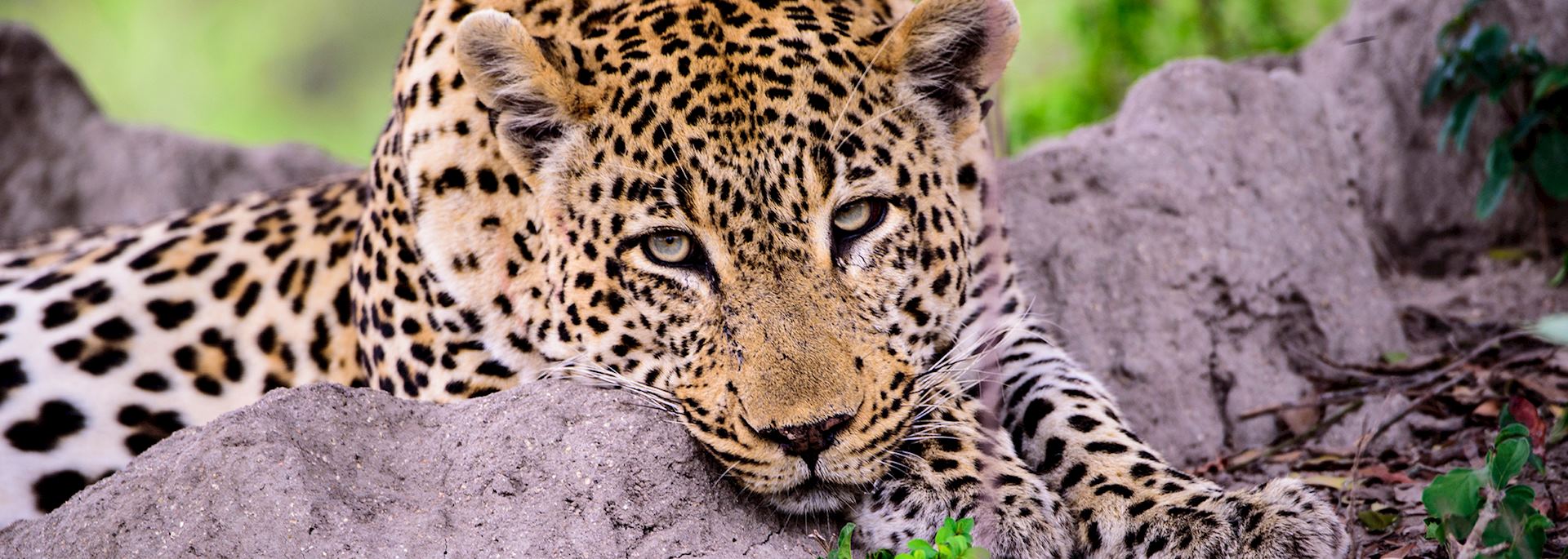
Big Five safaris
Lion, leopard, elephant, rhino and Cape buffalo — the Big Five are among the most sought-after animals to encounter on an African safari. While some are widespread, others, such as rhino, are dwindling in number and often require local know-how to find (along with a pinch of good luck). There are only a few areas in Africa where you have a chance of seeing all five animals on one trip, and each one offers a different safari experience. Our safari specialists discuss the options, and the best ways to see the Big Five during your safari.

Start planning your tailor-made trip by contacting one of our safari specialists
- 617-223-4521 617-223-4300
- Make an inquiry
Big Five safari itinerary ideas
Our itinerary ideas can be as tailored as you’d like around your particular interests. These selected suggestions will give you some inspiration, but treat them just as a starting point because for your own trip will be created uniquely for you.

Botswana's Okavango Delta & Victoria Falls safari
10 days from $11,985pp

Classic northern Tanzania safari
7 days from $8,200pp

Mara & Mahé explorer
13 days from $8,375pp
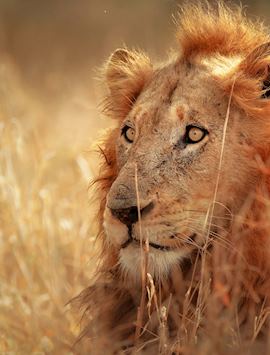
Kruger safari & Mozambique explorer
10 days from $15,775pp
South Africa’s Greater Kruger for your best chance to see the Big Five
The Greater Kruger National Park is so massive it’s able to support animals in huge numbers. You might see buffalo herds 500 strong and lion prides napping beneath mopane trees. And, the reserves here have been established for a relatively long time, so animals have become accustomed to vehicles. I’ve been on game drives and had leopard come within a few steps, as if we were invisible.
One of the oldest private reserves, Sabi Sands Game Reserve is particularly known for its leopard sightings. In reserves like this, you’re able to drive off road and at night, which gives you a better chance of seeing them at close range and as they switch to hunting mode after dark.
This area of South Africa is well protected and has become a stronghold for rhino. You sometimes encounter them on bush walks — your guide will be expert in looking for tracks and noticing telltale signs of their presence.
White rhino are easier to find than black rhino because they graze on open plains and are generally more docile compared with their shyer relations, which stick to denser thickets.
I’ve encountered all of the Big Five on bush walks here, but exploring on foot tends to focus more on smaller wildlife — insects, birds and reptiles, as well as plant life.
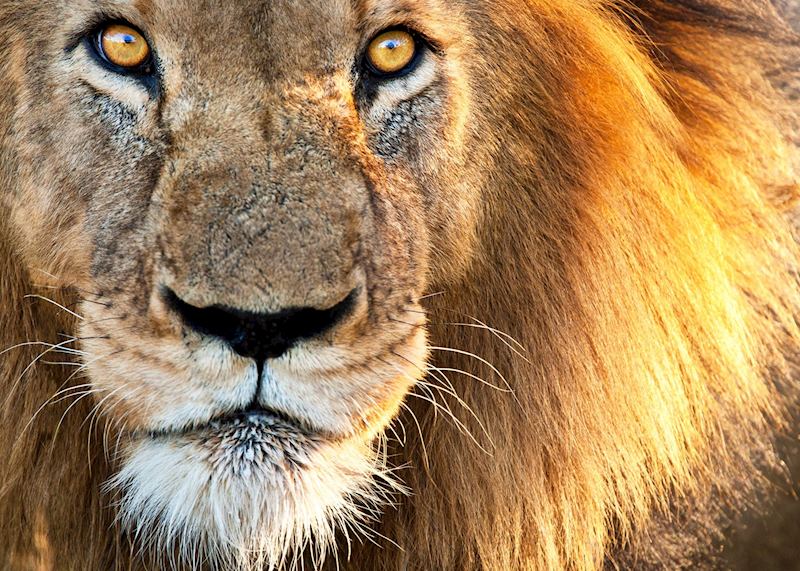
Game drives are normally the best way to track down the Big Five. You’re joined by a guide and a tracker, who know where the animals are likely to be found.
They’re also in radio contact with other vehicles, which keeps you in the loop of any key wildlife encounters while ensuring that no more than three vehicles are present at a sighting.
Other wildlife highlights : It seems like there’s barely an animal that isn’t in the park. Zebra and antelope cover the plains, giraffe nibble the trees, and there are more than 500 bird species. Wild dog are also present, though more difficult to see.
Where to stay : In Sabi Sands Game Reserve, I like Notten’s Bush Camp , a family-run lodge overlooking a waterhole. Your chalet has a private deck, where you can sit and look out across the plains.
When to go : The dry conditions between April and October, when the animals congregate around water sources, make for the best wildlife sightings.

The Big Five with Audley Travel
South Africa is arguably the best place in Africa to see the Big Five: lion, elephant, Cape buffalo, leopard and rhino. In this video, safari specialists Kirsty, Alex and Margaret discuss the country’s best parks and reserves for crossing the animals off your list.
Kenya’s Masai Mara for seeing the Big Five in a classic safari setting
The Masai Mara's variety of habitats suits a wide spectrum of animals — open savannah for grazing buffalo, wildebeest, zebra and antelope, acacia trees that shade leopard, lion and cheetah, and waterholes populated by families of elephant.
While you can see all of the Big Five, the lion sightings here are particularly special. The reserve supports one of the largest concentrations of lion on the continent, though populations are declining due to pressures on the land.
On game drives, my guide would point out each member of the prides we came across. I heard about the hierarchy, the different personalities and why the lion were behaving in certain ways. At night, you can often hear their roars carrying across the plains.
You’re limited to game drives in the main reserve, but stay on one of the bordering Maasai-owned private conservancies and you can head out on bush walks. While these don’t necessarily focus on seeing the Big Five, you’ll still track the animals, looking for prints and droppings left in their wake.
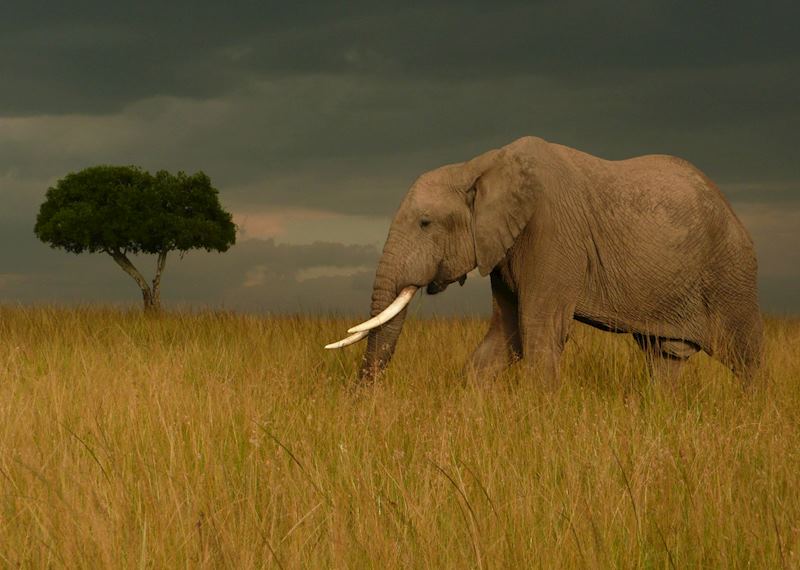
I was walking close to some trees when my guide raised a hand to stop me and indicated for me to listen. I could hear the cracking of twigs and rustling leaves, and there was a musky, earthy smell in the air. ‘There are elephant just in these trees,’ my guide whispered. While the elephant remained hidden from view, just knowing it was a few steps away was exhilarating.
You can enjoy a hot-air balloon flight over the reserve, taking off just in time for sunrise. I did this on my final morning, by which point I’d seen all of the Big Five except rhino, which are dwindling and notoriously difficult to find. From the air, I could pick out herds of elephant marching in line and grazing wildebeest scattered across the savannah, but my morning was made when my guide pointed down to a black rhino.
Other wildlife highlights : Millions of wildebeest and zebra populate the Masai Mara between August and October as part of the Great Migration, attracting big cats including cheetah.
Where to stay : I like Ol Seki Hemingways Camp in the Naboisho Conservancy. Your large canvas tent overlooks the Naboisho Valley, and most of the staff grew up close to the camp so can share their encyclopedic knowledge of the local wildlife.
When to go : July to October sees dry conditions and coincides with the Great Migration.
Tanzania’s Serengeti for spotting the Big Five alongside the Great Migration
If you have a wildlife tick list, chances are you’re going to complete it during a safari in the Serengeti . The sheer number of animals that inhabit the park’s vast open plains is difficult to fathom.
On game drives, you’ll pass masses of wildebeest (the migration herds are present in the park for most of the year), which in turn attract big cats.
Lines of elephant plod along well-trodden routes linking the park’s waterholes, which have been worn into the landscape over generations. And, while buffalo can be a bit harder to come across, I’ve seen lone males standing atop outcrops to gain a better vantage over the plains.
While game drives are the main way to see the Big Five, you can also take a hot-air balloon flight over the Serengeti at dawn. Not only does it give you a bird’s-eye perspective over the animals, but you also begin to appreciate just how big the Serengeti is.
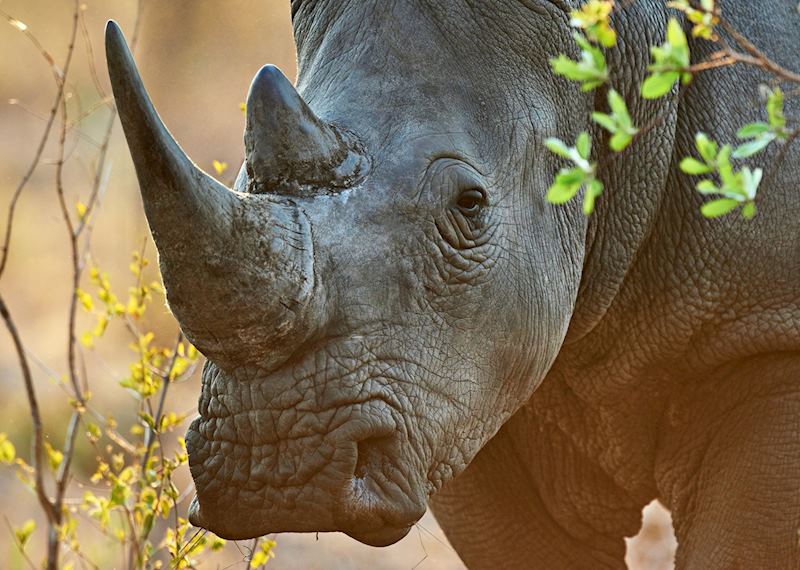
You could pair a visit to the Serengeti with a safari in the Ngorongoro Crater. This huge, sheer-sided caldera has formed a natural bowl filled with wildlife, and is the best place in Tanzania to see rhino. You’ll explore the grasslands and pockets of forest on game drives, passing herds of wildebeest, zebra and eland while looking out for the rest of the Big Five.
Other wildlife highlights : You can visit an area within the Serengeti that was closed for 20 years for cheetah research. It still has a healthy cheetah population, making for some excellent close-range sightings.
Where to stay : Sayari is a tented camp in the northern Serengeti, where you’re well placed for seeing the Great Migration herds pass into the Masai Mara. The camp’s 15 large canvas tents have private verandas facing the plains, and you can soak in the infinity pool while looking out for passing wildlife.
When to go : During the dry season, between July and October, to see animals congregating around waterholes and, in the northern Serengeti, the Great Migration herds.
Botswana’s Okavango Delta for tracking the Big Five in a wilderness setting
Spreading across northern Botswana like an outstretched hand, the Okavango Delta has year-round water and lush foliage, attracting a wide variety of animals including the Big Five.
What I like about this area is the feeling you get of being in absolute wilderness. There are barely any other vehicles around when you head out on game drives, camps are kept to an intimate size, and you rely on the tracking skills and local knowledge of your guide to find animals rather than following other vehicles.
Of all the Big Five, rhino are the most difficult to find. They’re generally only seen in a couple of locations and very rarely. One place you could try is Chief’s Island in Moremi Wildlife Reserve , where you can track them on foot or on game drives.
A guide and, in some instances, a tracker will accompany you on game drives. As well as looking for larger animals, they’ll point out each bird you pass, from lilac-breasted rollers to carmine bee-eaters, and pause to show you freshly pressed paw prints in the ground.
The watery landscape is ideal for elephant and buffalo, as well as hippo, sitatunga, red lechwe and a wealth of birdlife. Motorboat or mokoro (traditional canoe) trips along the reed-lined waterways get you closer to the wildlife.
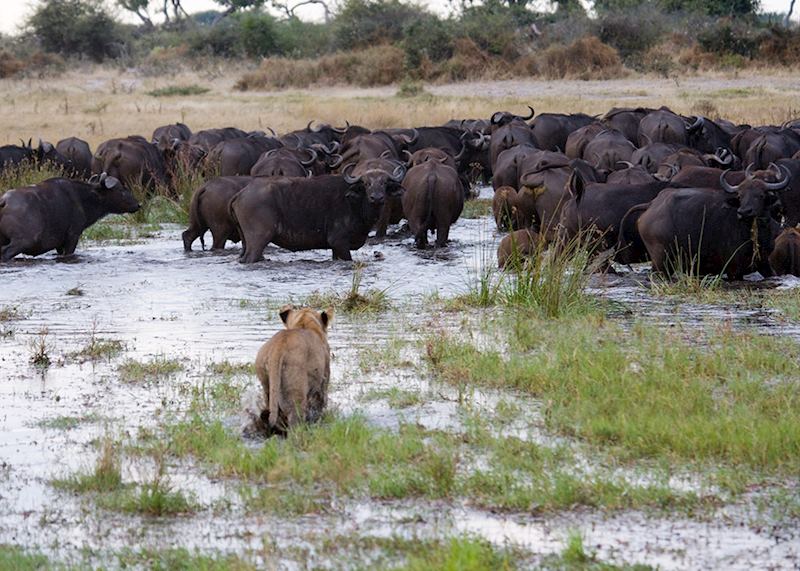
There’s a chance of seeing buffalo coming down to drink and elephant rolling on the muddy banks. Hippo peek their eyes just above the water’s surface, pied kingfishers hover overhead, fish eagles screech from the branches of dead trees and crocodiles bask on the banks.
Other wildlife highlights : Though never guaranteed, wild dog sightings are good in this area (on one game drive, I followed a pack of seven as they set off on their evening hunt).
Where to stay : Camp Okuti sits in the heart of Moremi Game Reserve and offers both game drives and boat safaris. This is one of the few places in Botswana where you have a chance of seeing all the Big Five. You stay in traditional mosasas (reed houses), each of which has a private deck with views over the river.
When to go : June to November is when the delta has the most water and more water-based activities are available. By September, vegetation has died back and animals are easier to see.
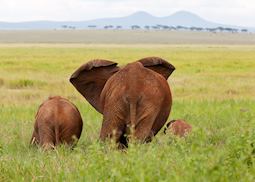
Tanzania safaris: north vs south
With the Great Migration taking place in the north and true wilderness areas stuffed full of animals in the south, you’re spoiled for choice when choosing a safari in Tanzania. Using his first-hand experience, Tanzania specialist Dickie shares his ideas for a memorable safari vacation.
10 min read
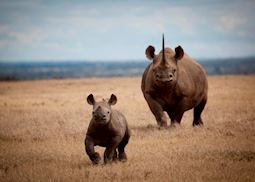
The Big Five in Kenya
Home of the Masai Mara and Lewa Wilderness Conservancy, you'll have countless opportunities to spot the Big Five in Kenya. With a range of first-class lodges, you can embark on traditional game drives and walking safaris in search of these magnificent animals.
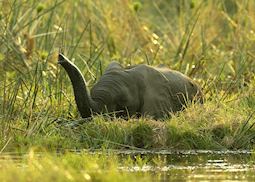
Okavango Delta safaris
The Okavango Delta is safari by water, where you glide in canoes through waterways and twinkling lagoons in search of hippo, elephant, giraffe and iridescent birdlife. Discover the best time to visit this wonderful water world and how we can help you plan your safari there.

African Big Five Safari: Lion, Elephant, Rhinoceros, Leopard and Buffalo

The African continent is famous for its wildlife and the game drives. The chance to watch the African Big Five in their natural habitat is always a sight to behold.
The Big Five comprises of the lion, buffalo, elephant, rhino and the leopard. They are considered the big five due to their dominance and assertiveness in the wilderness in comparison to other animals.
Tourist from all over the world travel to Africa to watch and experience nature at its best. Some of the most breath taking moments include the wildebeest migration and a hot air balloon excursion over the park.
In addition to that an interaction with the local community on their culture and traditions has always been found to be a bonus. Here are the African Big Five and the best safari destinations to see them.
See also: How Long to go on a Safari
The lion is a member of the cat family and regarded as the king of the jungle. It is in charge of a pride but in some instances it can live in the jungle alone. An adult lion can hunt and bring down any animal in the jungle. It is a strong, brave and ferocious hunter in the jungle.
In order to assert their dominance and authority, lions mark their territory by urinating and scratching on the ground. This is done in order to caution other lions and animals of a certain lion’s territory. There are usually fierce and bloody fights when lions cross into another pride’ territory which can result to fatal injuries or even death.
An adult male lion has a fully grown mane which is seen as a sign of masculinity and authority.
When visiting a game park, tourists are cautioned against petting the wild animals, feeding them or leaving the vehicle because they will be endangering their lives.
In the south and east of Africa there are still protected areas where lion populations live in larger numbers. A safari offers the opportunity to experience these animals up close. It doesn’t matter if you are planning a self-organized trip or opting for a package tour.
In West Africa, there are only about 200 lions left in three designated sanctuaries
- Niokolo-Koba National Park in Senegal ;
- the W-Arly-Pendjari Lion Conservation Unit (Benin/Burkina Faso/Niger), home to the majority of the West African population;
- Lake Kainji National Park in Nigeria ;
East and South Africa are home to most of Africa’s lion populations. If you’re looking for a unique destination to experience these mighty beasts, check out the following African countries:
- Tanzania offers a variety of national parks such as Serengeti , Katavi and Ruaha , as well as protected areas such as Selous and Tarangire – all perfect for safaris in your own 4×4 or as part of an organized tour.
- Neighboring South Africa also offers plenty of opportunities to see wild lions – from the world famous Kruger National Park to Madikwe Game Reserve and Kalahari Transfrontier NP .
- Botswana is known for its stunning wildlife; you are guaranteed to find Chobe NP , Moremi Game Reserve in the Okavango Delta and Central Kalahari GR .
- Namibia also has some gems in store: visit Etosha National Park or Kaudom NP !
- In Kenya , you can go on exciting photo safaris through the Masai Mara GR ; Tsavo East & West are also great destinations!
- In Uganda , Murchison Falls National Park , Queen Elizabeth NP and Kidepo Falls magically attract many adventurers.
- And a trip to Zambia is also worthwhile! North and South Luangwa NP as well as Liuwa Plain , Kafue NL & Lower Zambezi will give you unique memories.
- Another recommendation are the national parks in Zimbabwe like Mana Falls , Hwange or Gonarezhou .
- Akagera NP is a real insider tip for game viewing in the middle of tiny Rwanda !
- Mozambique also has something to offer with Gorongosa NP .

The elephant is the largest mammal on land with tasks, huge ears and big foot to assert their authority. They are very protective of their calves and the herd. Elephants do occupy huge tracts of land and require a lot of food and water.
It is a magnificent sight and adventure sighting a pride in the game parks. However, due to the increasing demand for tusks in the black market. There has been a sharp decline in population of elephants, this has seen them being categorized as endangered species. And still, there are still a pleasing number of elephants in Africa, estimated to be between 400,000 and 415,000.
These impressive animals can be found everywhere south of the Sahara and live in smaller and larger populations in a total of 36 African countries. Botswana, Zimbabwe, Tanzania, Gabon, Kenya and Zambia are home to particularly large numbers of these majestic creatures!
To see the elephant in the wilderness, a visit to the many game parks in Africa will be worthwhile.
Here are the best spots to find elephants in Africa
- You may be surprised to learn that Botswana is the country with the most elephants in the world. There are about 130,000 of these majestic animals – nearly a third of all African elephants and more than four times the number of elephants in all of Asia. Especially in the northwest of the country, large herds of up to 200 elephants can be seen – an unforgettable sight! The famous Okavango Delta and Chobe National Park are the best places to see them.
- Tanzania is home to an estimated 43,000 elephants spread across the country’s various national parks – including the world-famous Serengeti . If you want to see the majestic giants, however, you should venture to the northeastern Tarangire National Park . Here, the concentration of elephants is particularly high, and the best sightings are along the Tarangire River and in the shade of the impressive baobab trees. However, the largest population of elephants can be found in central Tanzania, in the neighboring Ruaha National Park and the adjacent Rungwa Wildlife Reserve .
- Kenya has many national parks and reserves that are home to elephants. These majestic animals are hard to miss on a safari. Especially in the Tsavo East National Park , which is very popular with tourists, large herds can be found. Here you will notice that the elephants have a reddish tinge due to the red soil. In the south of the country, on the border with Tanzania, is Amboseli National Park – a place known for its stunning elephant photographs against the backdrop of Mount Kilimanjaro .
- As an elephant lover, you will get your money’s worth in Zimbabwe . The country is home to the second largest population of free-roaming elephants in Africa and is less crowded by tourists, giving you an exclusive travel experience. Hwange National Park in the west of the country on the border with Botswana is particularly famous for its wildlife. Here you can roam undisturbed through the wilderness and experience majestic elephants up close.
- South Africa is undoubtedly one of the top safari destinations in Africa. An absolute highlight is Kruger National Park , which is not only the largest park in the country, but also home to hundreds of elephants. For an even better chance of seeing these majestic animals, make a detour to Addo Elephant National Park in southern South Africa, near the picturesque Garden Route and the port city of Port Elizabeth. Driving through the park, you may encounter elephants and it may be necessary to avoid them – they also like to stay in the middle of the road!
- Gabon is the perfect destination for animal lovers who want to see elephants, gorillas and the jungle up close. Although only two million people live here, there are 64,000 elephants to marvel at – including rare forest elephants, which are slightly smaller than their African relatives. For a more diverse experience, visit Gabon’s 14 national parks. Lopé-Okanda , a Unesco World Heritage Site, and Loango National Park on the Atlantic Ocean are particularly popular with tourists.

The leopard is a member of the cat family. It is considered to be a very shy cat and hard to spot in the game park. They reside on top of trees and spend most of their day time sleeping and hunt at night. The leopard has very good vision when it is dark, this makes it very hard to spot.
In addition, they are solitary animals and interact with each other when mating and raising their cubs. The individualistic nature of the leopard makes them vulnerable from other rivals such as lions and hyenas. This has greatly impacted their population thus making them few in the savannah.
Here are some of the best places to look for leopards in Africa
- If you’re dying to see a leopard in Africa, there’s a clear number one on the list: South Africa and Sabi Sand . This is home to the densest population of the majestic predator, and the area consists of a collection of private reserves on the western border of Kruger National Park. One of these areas is Londolozi in the Sabi Sand Private Reserve – a true paradise for leopard seekers! More than 50 of these impressive animals live in 100 square kilometers. The Madikwe Reserve near Botswana also offers a great chance to see one or more leopards during your safari through South Africa. Easily accessible from Johannesburg, this is an opportunity not to be missed!
- In the eastern part of Zambia , in the Luangwa Valley, lies South Luangwa National Park – the southernmost of the country’s three large national parks. An apt name for the area is “Valley of the Leopard” , as it is home to an impressively large population of these majestic big cats. The variety of prey in this area provides a veritable feast for the hungry leopards. Especially during night drives on a safari through Zambia, these fascinating animals can often be seen hunting. Permission for night drives makes it easier for wildlife watchers to spot the magnificent spotted hunters and learn about their hunting habits – an unforgettable experience!
- The Masai Mara in Kenya is known for its many big cats, attracted by the sheer numbers of wildebeest and zebra that have arrived at the northernmost point of their great migration. Undoubtedly, the reserve is one of the best places in Africa to view all wildlife – including a large population of leopards. Most sightings of these majestic predators occur along the Mara or Talek River. However, night drives are not permitted in the area.
- If you want to get up close to leopards on a Namibian safari, be sure to visit the Okonjima Nature Reserve in northern Namibia . The reserve is picturesquely situated at the foot of the Omboroko Mountains and is home to the renowned AfriCat Foundation, which cares for injured predators. You also have a good chance of spotting the majestic leopards of the Kalahari Desert . The open terrain makes it easier than in the densely vegetated savannahs or forests of other parks.
- Many visitors come to the Serengeti National Park in Tanzania to experience the awe-inspiring spectacle of the great migration. However, it is important to remember that where wildebeest and zebra roam, predators may not be far behind. The Seronera Valley is a particularly good place to go if you want to see leopards. In addition, Keekorok , Sand River and various game reserves also offer excellent opportunities to view the majestic animal with the spotted coat – during a safari through Tanzania’s incomparable landscape!
- There are many excellent places to go on safari in Botswana to see leopards. The best of these are on the edge of the Okavango Delta , notably the Linyati Reserve and Savuti (between the Okavango and Chobe National Parks). For many connoisseurs of safari culture, however, the Moremi Game Reserve is unsurpassed as a destination. Overall, it is the lagoons and floodplain forests that are most popular with wildlife enthusiasts – exactly the areas favored by these majestic big cats. The Moremi Reserve protects a significant part of the beautiful ecosystem of Botswana’s famous river delta with all its magnificent wildlife!

The rhino is known for its awesome giant horns which grow from their snorts. They are huge animals with a heavy thick skin and hooves. They live in huge tracts of land, their bold and courageous nature makes very aggressive.
There are two types of rhinos; the white rhino and the black rhino. A black rhino has shorter head from the head to the mouth with a protruding smaller head size. A white rhino on the other hand, has a longer less protruding head and a longer skull.
The high demand for their horns has seen an ever increasing poaching activity which has greatly affected their population and survival in the jungle. Despite that, the rhinoceros is one of the iconic wild animals in the African savannah.
About 75% of Africa’s rhinos live in South Africa alone. But does this automatically mean that the best place to see them is in the country at the Cape? The answer is “no”. Seeing these majestic animals on an African safari does not depend solely on their numbers in a particular country. Their behavior and conservation status in a particular region also play a crucial role. So where should you look for the best rhino viewing areas?
Here are the best places for rhinos in Africa
- You’ll find Matobo National Park south of Bulawayo, Zimbabwe ‘s second largest city. This park is like another planet: the imposing rock formations are a fascinating contrast to the rolling grassland; the Matobo Hills offer breathtaking views and the historic rock paintings of the San people make it a UNESCO World Heritage Site; the protection of the white and black rhino is paramount here – the chances of seeing them during a safari are very high.
- In the eastern part of Botswana , near the Gaborone-Francistown highway, lies the Khama Rhino Sanctuary in the Kalahari Sandfields . The entire community works together to restore and protect historic wildlife populations. Whenever possible, rhino calves are translocated to other areas to be reintroduced into the wild. Another goal is to generate important income for the reserve through tourism and sustainable use of natural resources. The small reserve provides an excellent habitat for both white and black rhinos.
- Namibia has the second largest rhino population in the world and is home to both white and black rhinos. Etosha National Park in particular is home to numerous black rhinos. The park’s main camp, Okaukuejo, is known for its waterhole where the animals congregate. Especially at dusk and in total darkness this place becomes a popular meeting point for the local black rhinos – so far without any incidents!
- South Africa is the ultimate destination for rhino enthusiasts. Nearly 86.5% of the world’s southern white rhinos are found here. In the 1960s, an impressive mission to save these majestic animals began in KwaZulu-Natal’s Hluhluwe-iMfolozi Park . The park’s landscape ranges from rolling to mountainous, often with wide open spaces and breathtaking views. The chances of seeing majestic rhinos are particularly high in the iMfolozi section of the park.
- Nair ob i National Park in Kenya offers an exceptional opportunity to see rhinos up close. A visit to the Solio Game Reserve (or: Solio Ranch) in the immediate vicinity of the Aberdare National Park in the Laikipia region is also worthwhile – here you are almost certain to encounter these majestic animals. But we especially recommend the Ol Pejeta Conservancy . And why is that? Because it is currently the only place in the world where you can see Black Rhino, Southern White Rhino AND Northern White Rhino!

They are regarded as the most dangerous animals in the wild. Very aggressive and mean to anything regarded as a threat. The African Buffalo is so aggressive it has never been tamed. Since they live in herds, it becomes hard for lions to hunt and in some cases they have severely injured and killed lions.
The African buffalo is a good swimmer, has a very intricate social structure and huge horns which they use to defend themselves against predators. They are known to rest in the open except in extreme sunshine. Thus they are they are the most common animals to be seen in a game drive.
The average weight of the buffalo is 480-550 kgs. The weight and huge body frame has been used in defense from both human and wild animal attacks. They tend to consume a lot of grass thus they are more common during the rainy season.
It is gratifying to see that despite the declining population, the buffalo have not been endangered for several years.
Best places to find buffalo in Africa
If you take a drive through a national park, you are almost certain to see many of these majestic animals.
Especially in certain regions, such as the Queen Elizabeth National Park in Uganda or the Masai Mara in Kenya , herds of up to 800 buffalo can be seen.

In conclusion, the African big five is an interesting and intriguing category to see. They have a unique way of survival and they have been found to a key tourist attraction.
View all posts
RELATED ARTICLES MORE FROM AUTHOR
Top seychelles travel tips: not to miss islands and beaches, a guide to visiting lower zambezi national park, how to trek to point lenana on mount kenya, check out & follow:, similar travel tips, the most annoying things airline passengers do, tips for sleeping in your car, a guide to the best international events in marrakech, explorer videos, costa brava, spain: the nature and activity guide, costa brava, spain: the culture guide, activities you weren’t expecting to do in hainaut, belgium, more travel tips, easy tips to outsmart pickpocketing in europe, the most overrated tourist attractions on the planet, travelling in a pandemic: crucial safe travel tips, follow us on instagram @/traveldudes/.
- Advertise and Media
TOP DESTINATIONS
- Kruger Park
- Okavango Delta
- Serengeti National Park
- Victoria Falls
TOP COUNTRIES
- South Africa
TRAVEL DEALS
View All Travel Deals
SOUTHERN AFRICA
East africa, indian ocean islands, top experiences.
- Beach Holidays
- Family Safaris
- Honeymoon Safaris
- Desert Safaris
- Luxury Rail Safaris
- Multi-Generational Safaris
- Positive Impact Safaris
- Photographic Safaris
- Walking Safaris
WILDLIFE SAFARI
- Big Five Safaris
- Birding Safaris
- Gorilla Trekking Safaris
- Migration Safaris
- Mobile Camping Safaris
- Horseback Safaris
FEATURED EXPERIENCES
Comfort levels, property types.
- Tented Camps
- Boutique Hotels
Featured Safari Collections
- Desert & Delta
- African Anthology
- Imvelo Safaris
- Newmark Hotels
GET TO KNOW US
- Meet The Team
- Pricing Explained
- Traveller Reviews
- Traveller Stories
- Why Book With Us?
- HerdTracker
- Safari Cost Calculator
- South Africa In 360
- Trusted Safari Partners
What are you looking for?
- Safaris & Tours
- Destinations
- Experiences
- Accommodations
- Why book with us?
Hello traveller!
It's in Cape Town now.
We're sorry. Our safari planners aren't available now. Our office hours are 08:00 - 19:00 (GMT+2).
Call us to speak to an experienced safari planner.
Alternatively, we recommend...
Schedule a phone or Zoom call with one of our safari planners
Complete our travel enquiry form to connect with a safari planner
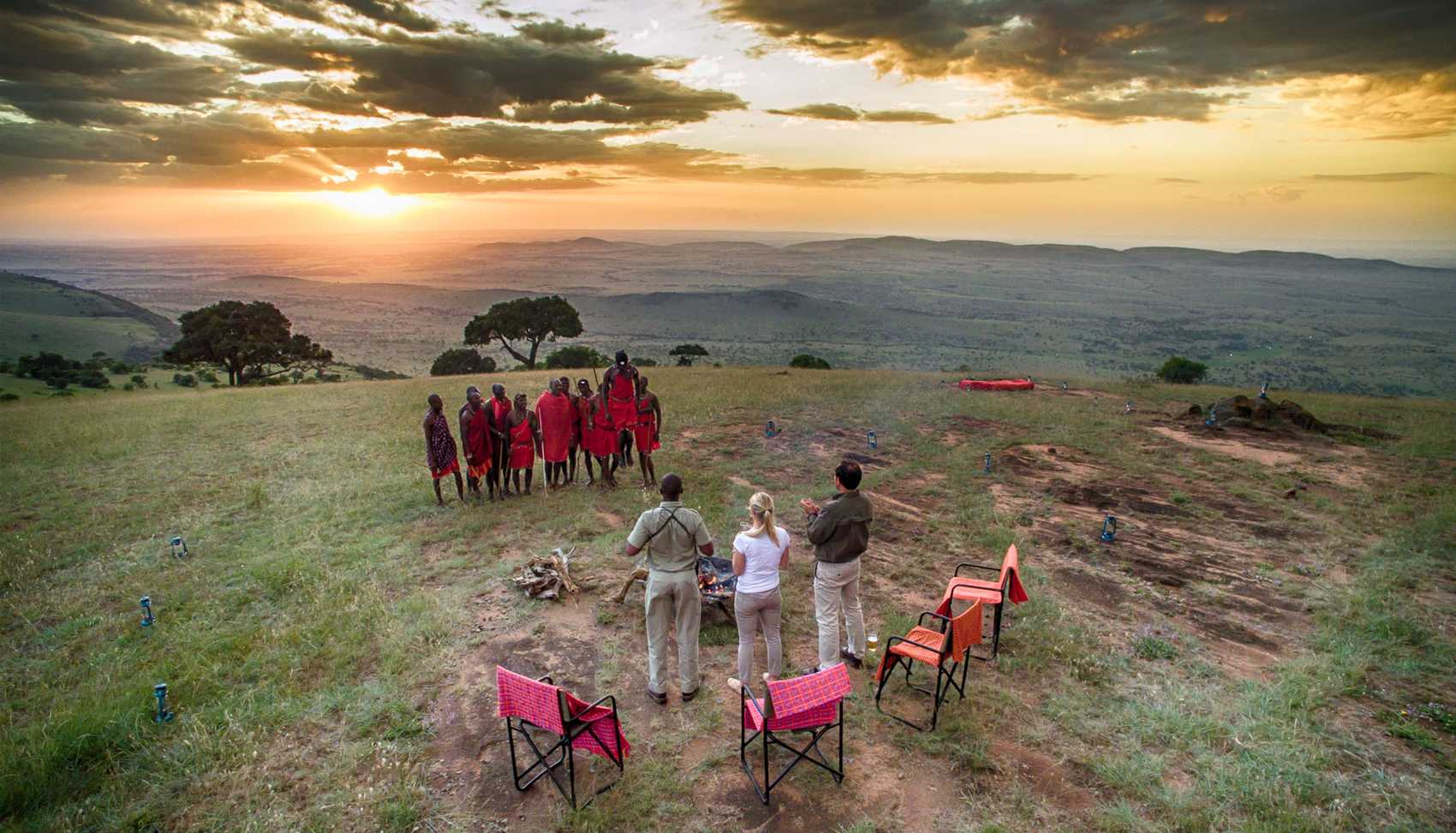
- Big Five Safaris in Tanzania
Africa's best authentic tailor-made safaris

By Diane Du Plessis
Safari Travel Planner
Seeing the Big Five up close and personal is a once-in-a-lifetime experience, regardless of how many instances you will get to experience it. Luxury safaris in Tanzania are an experience to savour and a number of camps will make for an unforgettable experience. In this case here are nine unforget table camps to see the Big Five in Tanzania.
One of the best camps in Tanzania found in central Serengeti is Dunia Camp. What makes it stand out is its remoteness, which is enticing for the Big Five. However, with the freedom the animals have, it’s best to be with a guide or tour group.
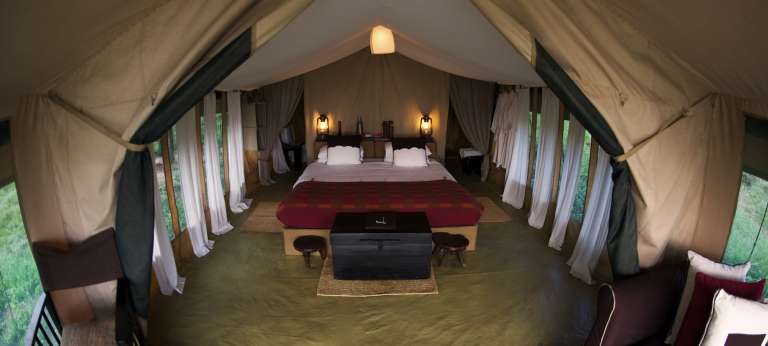
Strategically located in the remote plains of the eastern Serengeti, Namiri Camp is the best place to see the Big Five, especially the cats. In fact, since the camp banned poaching, the big cat numbers have increased, so chances of spotting them will be very good.
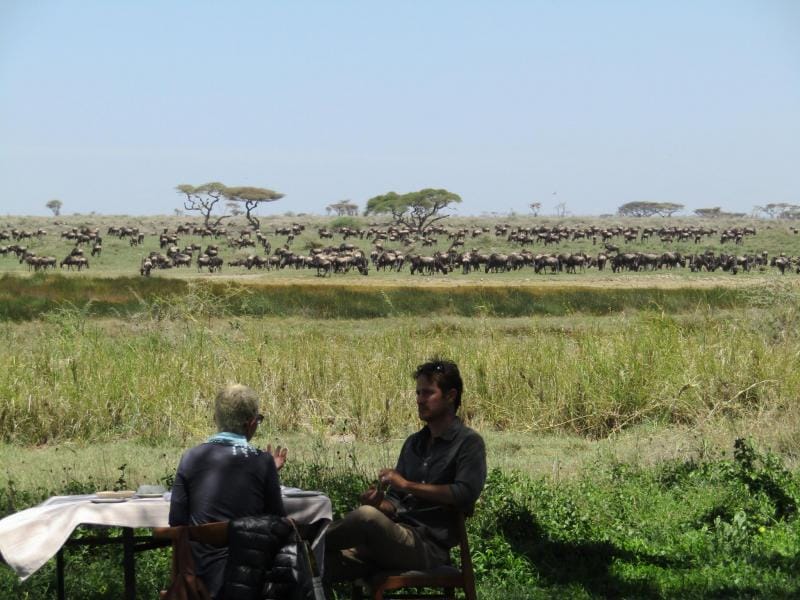
Ten percent of the world’s population of lion is in Kwihala. This means that when you visit Tanzania, it’s not surprising to see prides consisting of more than 20. The best part is that Kwihala is full of life with many other species of animals such as jackal, hyena and wild dog.

Jabali ridge is a goldmine, teeming with wildlife, where predators and prey roam freely in the wild. Action packed days are guaranteed – elephant and rhino are so close, that you’ll be sure to feel their power.
Located in northern Serengeti, Kimondo Camp is full of buffalo and rhino. With the help of a guide, adrenaline-filled campers get the unique opportunity for an up-close and personal Big Five experience.
The award-winning Sayari Camp is revered for extraordinary wildlife sightings, including the Big Five. Set on the unspoiled plains of the northern Serengeti, close to the famous Lamai Wedge, Sayari gives you easy access to the Mara River and multiple river crossing points.
When looking for a great wildebeest migration meeting with the bonus of a Big Five encounter, Olakira camp in Northern Serengeti is the place to be. With the action-packed scenes so prolific, the experience will stay with you for a lifetime.
How it Works
View our recommended safaris for inspiration and get ready to plan your dream safari
Contact us or fill out an enquiry form and one of our travel experts will help you tailor make your perfect safari
Enjoy an authentic African experience.
Travel with Confidence
With over 20 years of experience, our team will help you tailor your itinerary to your perfect adventure., 24/7 support, personalized, popular tanzania safaris, these recommended tours for tanzania can be tailor-made to match your budget..
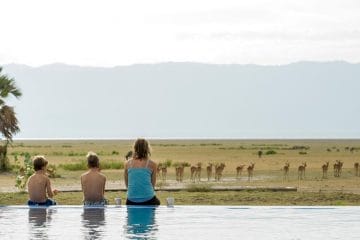
Family Safari in Tanzania
East Africa Tanzania Tarangire Lake Manyara Serengeti Ngorongoro Crater
From $ 14790 /USD
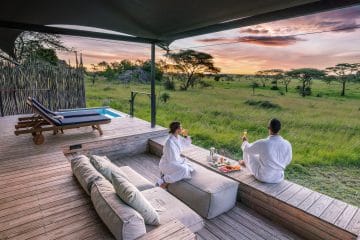
Honeymoon Safari in the Serengeti National Park
East Africa Tanzania Ngorongoro Crater Serengeti
From $ 6240 /USD
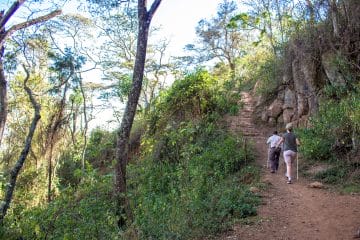
Walking Safari Experiences in Tanzania
East Africa Tanzania Lake Manyara Ngorongoro Crater Serengeti
From $ 7750 /USD
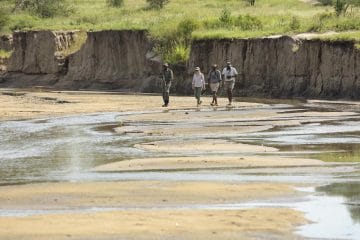
Affordable Migration Safari from June to Octobe...
East Africa Tanzania Arusha Tarangire Lake Manyara Ngorongoro Crater
From $ 6800 /USD
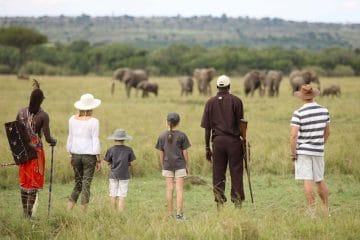
Walking Safari in the Serengeti
East Africa Tanzania Serengeti Lake Manyara
From $ 5850 /USD
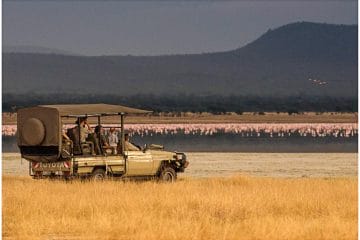
Highlights of Tanzania Group safari
East Africa Tanzania Lake Manyara Serengeti Ngorongoro Crater
From $ 2600 /USD
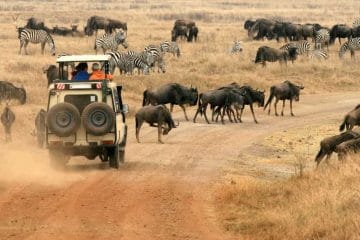
47 Tanzania Safaris to choose from
Stay for 4 - 17 days
Experience our Tailor-made Tours in Tanzania
Our recommended tours in tanzania.
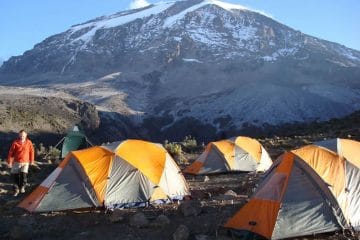
Kilimanjaro Climb with the Machame Route
East Africa Tanzania Arusha Kilimanjaro
From $ 4490 /USD
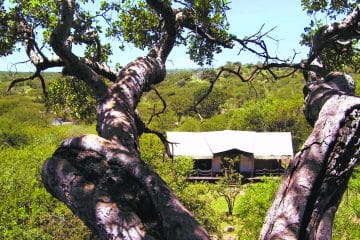
Herdtracker Migration in Central and North Sere...
East Africa Tanzania Serengeti
From $ 8390 /USD
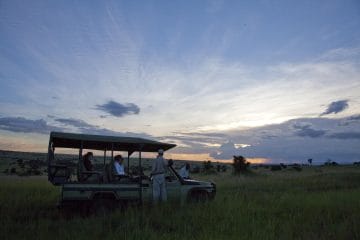
Best of Africa
Botswana Okavango Delta South Africa Johannesburg Kenya Nairobi
From $ 19690 /USD
Why travel with us?
Recent reviews from travellers who planned and booked their africa trips with discover africa safaris, very professional and efficient with a first class personal support and excellent....
13 Day Kruger & Cape Town Family Safari Review
Ben Mason, United Kingdom 03 Nov 2023
Great itinerary and excellent customer support..
14 Day South Africa Tour Review
Simon, United Kingdom 01 Nov 2023
Botswana & Victoria Falls Family Getaway
Susan Easterly, United States 25 Jul 2023
Many thanks adelle for your precious help.
Timbavati & Sabi Sands Safari Review
Donald, Canada 01 Nov 2022
Trip of a lifetime..
9-Day Victoria Falls Tour Review
Melanie Austin, Canada 07 Dec 2019
Amazing safari tour in africa.
Safari Tour in Africa Review
Enrico Liberati, Italy 09 Sep 2016
Ready to plan your tailor-made safari.

Adelle Belle, Safari Travel Planner
Free safari planning advice from destination experts
- Why Tanzania
- Tanzania in January
- Tanzania in February
- Tanzania in March
- Tanzania in April
- Tanzania in May
- Tanzania in June
- Tanzania in July
- Tanzania in August
- Tanzania in September
- Tanzania in October
- Tanzania in November
- Tanzania in December
- Beaches of mainland Tanzania
- Northern Safari Circuit in Tanzania
- Serengeti to Ngorongoro Crater
- Southern Safari Circuit in Tanzania
- Zanzibar and the Indian Ocean Islands
- Hot air ballooning
- A Relaxing Safari in Tanzania
- Adventure Safari in Tanzania
- An Active Tanzania Adventure
- Birding Safari in Tanzania
- Photographic Safari in Tanzania
- Walking Safaris in Tanzania
- A Couple Safari in Tanzania
- Family Safaris in Tanzania
- Honeymoon in Tanzania
- LGBT Safaris in Tanzania
- Solo Travel in Tanzania
- A Budget Safari in Tanzania
- Affordable Safaris in Tanzania
- Luxury Safaris in Tanzania
- Culture in Tanzania
- Dining in Tanzania
- Emergencies in Tanzania
- Health Care in Tanzania
- Languages Spoken in Tanzania
- Lodges in Tanzania
- Money Tips in Tanzania
- Packing List for Tanzania
- Safety in Tanzania
- Shopping in Tanzania
- Tanzania Health Insurance
- Tanzania Visa Requirements
- Tanzania vs Kenya
- Tanzania vs Rwanda
- Travel Advice for Tanzania
- Travelling to Tanzania
- Vaccinations for Tanzania
- Welcome to Tanzania
- Where to go in Tanzania
- Why go to Tanzania
- Wildlife in Tanzania
- Tanzania Safari
Registered Members of these Organizations

USEFUL LINKS
- Safari Tours
- Accommodation
- Why Book with us?
- Safari Cost Estimator Tool
- Wildebeest Migration
- Privacy Policy
- Website Terms of Use
POPULAR COUNTRIES
- View All Countries
POPULAR DESTINATIONS
- View All Destinations
- Cape Town Holidays
- Kruger National Park
- Etosha National Park
- Chobe National Park
TRAVEL BLOGS
- Travel News Digest, 17 May: Brits Flock to SA, Maasai Mara Flood Impact, Africa’s Tourism Potential
- Tanzania and Kenya’s Top Great Migration River Crossings With all the Action
- HerdTracker Heroes: Celebrating Our Top Contributors
- Transformative Journeys: From South Africa’s Red Desert to Antarctica’s Crystal Glaciers
- Travel News Digest, 10 May: Airlines Warned to Cease Greenwashing, Free Wi-Fi at Victoria Falls
OUR LOCATION
2nd floor, Tygervalley Chambers One, 27 Willie van Schoor Avenue, Bellville, Cape Town , 7530
Predators and Primates of East Africa: Rwanda and Tanzania
June 17 - 29, 2025
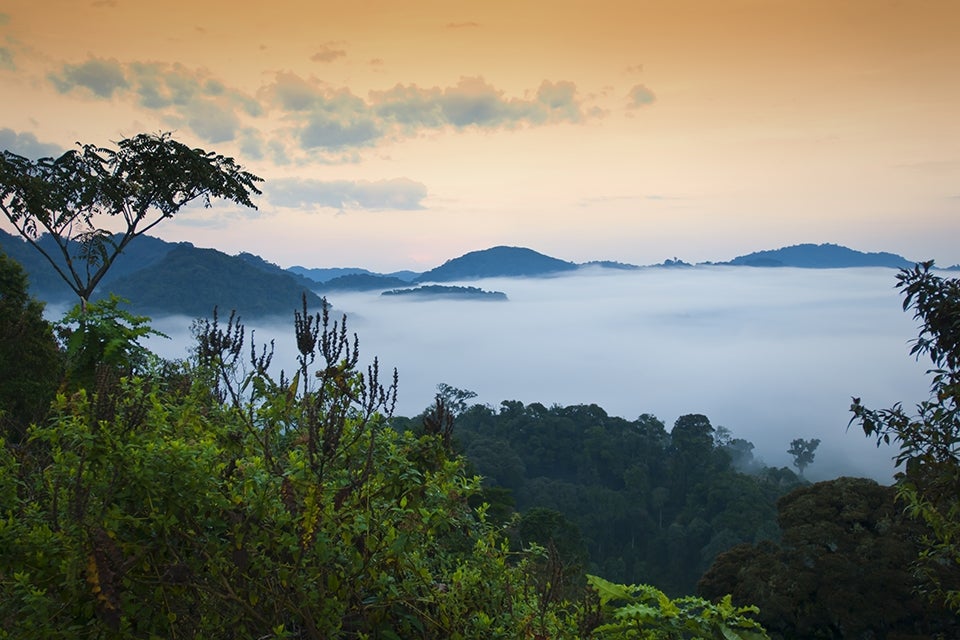
Group Size: 7 -14 travelers Price: Starting from $15,495 per person, double occupancy Co-sponsored with: Harvard Exclusive
Trip Overview
This program combines two premier African wildlife experiences (Big Five safari animals & Mountain Gorillas) in one seamless, choreographed adventure. Starting from Arusha, fly to Tanzania's famed Serengeti National Park. Over the next three days, delve deep into the savannah, wooded grasslands and riverine forests in search of lion, leopard, cheetah, and thousands of hoofed mammals. Next, fly to the Ngorongoro Highlands for a two-night stay at the award-winning Gibb's Farm where the food is literally farm fresh and a wide range of activities and spa services await. From Gibb's Farm, you will venture to Ngorongoro Crater in search of the Big Five ( lion, leopard, rhinoceros, elephant, and African buffalo). Finally, take a quick flight over to Rwanda in search for the endangered silverback gorillas. Trek through dense forest with a team of guides and rangers to find these massive beauties for an awe-inspiring end to your African adventure!
Schedule by Day
Depart U.S for Kilimanjaro Airport
Arrive into Kilimanjaro Airport where you will be met and transferred to your lodge in Arusha.
Overnight: The Arusha Hotel
Fly from the busy town of Arusha to the quiet, open plains of the Serengeti. There are often stunning views during the one-hour flight over the farm-dotted highlands and valleys below. Upon landing in the Serengeti, you will be greeted by your guide and begin your safari adventure. The word “Serengeti” derives from the Maasai “Siringet” and has been artistically translated as “the land that flows on forever”. Serengeti National Park covers thousands of miles of pristine land and offers not only expansive vistas but the largest migration of mammals on earth, including 1.5 million wildebeest.
Enjoy the journey to your next Nyumba camp, as there will be plenty to see along the way. Perhaps you will come across a chase between predator and prey; maybe you will spot a wake of vultures; or maybe you will be lucky enough to find a leopard relaxing high in the limbs of an acacia tree.
Spend an afternoon wildlife viewing in the Serengeti. The big cats often spend these hours lying drowsily about the plains and up in the trees while many antelope and other animals continue to graze.
After dinner, head to the campfire to swap the best adventures and photos from your day with your fellow travelers.
Overnight : Central Serengeti Nyumba
Meals: B, L, D
Those with advance reservations will have the opportunity to balloon across the plains during one of your mornings in the Serengeti. A pre-dawn wake-up call leaves you time to drive to the balloon launch site in order to catch the most dramatic light. Then take to the skies just as the sun rises. Glide over the plains and acacia treetops, taking in spectacular views of the Seronera River Valley and the surrounding plains. After your descent, enjoy a magnificent champagne breakfast right in the midst of the Serengeti wilderness.
Go on a late afternoon walk around your camp and enjoy the sunset. You may see signs of wildlife in the area by identifying spoor, searching for broken branches, and finding animal tracks in the sandy soil.
Spend some time at your Nyumba in the Serengeti this evening. Before dinner, enjoy a workout, utilizing the Nyumba’s Keep Fit Kit, or just put your feet up and relax in and around the dining tent, exchanging safari tales with your fellow travelers.
Embark on a full-day excursion into the Serengeti plains. Your expert guide will seek out the unique and diverse flora and fauna of the Serengeti, including the iconic herds of wildebeest and zebra as they migrate across Tanzania.
Spend more time seeking out wildlife and exploring the Serengeti's rich landscapes. The so called Big Five and the Great Migration are the most well-known of the Serengeti's offerings, but there is much more to see. Thousands of equally fascinating dramas of a smaller scale play themselves out on these endless plains.
Don't forget to look up! You won’t need a telescope to see the bright constellations in Tanzania’s pristine night sky.
Bid farewell to the flat grass plains of the Serengeti; your next stop is the Ngorongoro Highlands. Known for its red soil and lush landscapes, the Highlands sprawl over hills and valleys. Everywhere you look will unveil a new view, a new beauty, and a new adventure.
Take in your last glimpses of wildlife in the Serengeti on your way to the airstrip for a flight to Manyara.
Savor lunch at Gibb's Farm, where nearly every ingredient comes fresh from the estate's organic farm. With delicacies to suit every palate, this is sure to be a memorable meal.
Take a guided tour of Gibb’s garden, a sloping 10 acres of vegetables and fruit gardens, growing everything from artichoke to zucchini and providing most of the ingredients for the delicious organic meals enjoyed by guests. Learn about other sustainable practices at Gibb’s as your tour passes through a pig and dairy farm where you can even try your hands at milking a cow. You can also walk through the famed coffee bean fields that gave the farm its start over 80 years ago.
Take some time to catch your breath in your private cottage. Unwind with an outdoor shower, listen to the birds from your patio, or enjoy a drink as twilight fades in over the Ngorongoro Highlands.
Overnight : Gibb's Farm
Visit the Ngorongoro Crater, where you are likely to find an abundance of wildlife. With luck, you might even see rhinoceros and big cats, such as lion and cheetah. The diversity of species often inspires awe, from baboons and elephants in the Lerai Forest to wildebeest and mountain reedbuck over the crater’s grassy floor.
If you haven't spotted them already, spend the rest of the day trying to check the Big Five off your list! Lion, Cape Buffalo, Black Rhino, Leopard, and Elephant all live in the Crater - so you might see them all before you leave!
This evening, sip complementary sundowners on the poolside terrace and enjoy the night’s entertainment. Choirs, instrumentalists or storytellers may perform, depending on the evening, as the sun sets in picturesque fashion over the coffee farm. With comfortable seating and variety of drinks, it offers a wonderful place for conversation and stargazing.
Breakfast at Gibb's is a great way to start the day. Enjoy local fruits, homemade yogurts and fresh cheeses, and made-to-order breakfast classics like omelettes or pancakes. Everything is made with the freshest ingredients.
Located just outside the village of Mto Wa Mbu, African Galleria is a reputable art gallery and jeweler offering a wide array of fine art, carvings and precious stones. Featuring an on-site lapidary and expert staff, this is one of the best locations in Tanzania for purchasing Tanzanite gems.
Enjoy a delicious lunch and a visit to the adjoining Shanga workshop where physically challenged artisans create remarkable jewelry, learn glass-blowing, and sell their work. This extraordinary project was created in order to mentor and empower those who are often marginalized in Tanzanian society. You will be surprised and inspired by the quality and beauty of their creations.
RwandAir Flight from Kilimanjaro International Airport to Kigali. Enjoy a quiet dinner at the lodge this evening.
Overnight : Kigali Serena Hotel - Deluxe Room
Meals: B, D
After breakfast, take a tour of Kigali with your guide. While in the city of Kigali, visit the Rwandan Genocide Memorial, where you can peruse the interior exhibits as well as the beautiful memorial gardens. En route through Kigali, you will stop for lunch in the city.
This afternoon, you will head on a three hour journey across Rwanda's rolling green hills and farmland up to the Virunga Volcanoes where, on clear days, you can see up to five volcanic peaks. Settle into your rooms at the lodge where you can relax for the afternoon.
Overnight : Five Volcanoes Boutique Hotel
Head into the lush forest with a guide to search out troupes of Golden Monkey and observe them as they leap from branch to branch in the forest canopy. The Golden Monkey, a relative of the much more common Sykes Monkey, is playful and very curious. Two habituated troupes can be seen, numbering between 80 and 100 individuals. Once you find them, your time with the monkeys is limited to one hour of observation as they interact, play, groom and move gracefully through their forested surroundings.
For 55 years, the Fossey Fund has been working to help conserve wild mountain gorilla populations and support the people who share the gorillas’ forest home. Beginning in Diane Fossey's rudimentary tented camp in 1967, the fund shifted from one rented office to another until in 2022, when global icon Ellen DeGeneres funded the creation of a state-of-the-art campus. Enjoy a self-guided tour of the the multi-acre, eco-friendly facility set at the foot of the Virunga Volcanoes.
Before you set foot on the trail, your guide will brief you on what to expect and how to behave in the presence of the gorillas. As they are an extremely rare species living in a fragile environment, it is extraordinarily important for you to observe some simple rules. Please note that anyone suffering from cold or flu symptoms, or any other infectious conditions will not be permitted on the trek.
With your guide leading the way, explore the lush, dense forest in search of gorillas. Trekking conditions may be strenuous, so please be prepared with the proper equipment provided in your packing list. Once you find the gorillas, you will spend a maximum of one hour in their presence, during which any thoughts of strenuous hiking will be forgotten!
Your guide will drive you back to the city of Kigali at the end of your Rwandan adventure. Enjoy a day room in Kigali, resting up and readying yourself for departure. Transfer to the Kigali Airport for your flight home.
Day Room: Kigali Serena Hotel - Deluxe Room
Arrive home.
- $15,495 per person, double occupancy
- $2,000 single supplement
Accommodations
- One night at The Arusha Hotel
- Three nights at the Central Serengeti Nyumba
- Two nights at Gibb's Farm
- One night at the Kigali Serena Hotel
- Two nights at Five Volcanoes Boutique Hotel
What to Expect
Tanzania - Most days will involve one or more of the following: A busy pace including walks on uneven terrain for up to 2 hours and long drives on bumpy, dusty roads.
Rwanda – Gorilla trekking requires a certain level of mobility, fitness and determination as it occurs on slippery, mountainous terrain with thick vegetation, insects and often steep inclines. Trek lengths vary depending on where the selected gorilla families are found. The average trek day requires 2 hours of trekking each way plus 1 hour of observation with the gorillas. Treks can be shorter or longer. We strongly recommend utilizing local porters to carry day packs and water. For guests in need of additional support, a litter basket can be hired.
Study Leader(s)

Related Trips
For more information.
Please email [email protected] or call our office at 800-422-1636 or 617-496-0806.

IMAGES
VIDEO
COMMENTS
What are Africa's Big Five? Meet the continent's most iconic wildlife. Once mostly targeted by hunters, these large species are "awe-inspiring" sights for safari-goers.
all about 'the big five' animals - African Elephant, Cape Buffalo, Leopard, Lion, Rhinoceros. The big five animals of Africa are African Elephant, Cape Buffalo, Leopard, Lion, and Rhinoceros. These five types of animals were named 'the big five' by big game hunters from African's colonial era, as they were considered the most ...
In the game reserves and national parks of Southern Africa, the Big Five represents safari royalty: the African lion, the African leopard, the African elephant, the Cape buffalo, and the rhino (either white or black). The phrase was initially coined by early game hunters who recognized that these species were the most challenging and most ...
The lion is arguably the most sought-after of the Big Five because it is synonymous with an African safari. Charismatic, powerful and beautiful, everybody wants to see the appropriately named 'King of the Beasts'. Once, hundreds of thousands of lions roamed the world, but today conservationists give approximate numbers of between 25 000 and 30 ...
The Big Five animals of Africa, in short, 'The Big 5' include the African elephant, rhinoceros, lion, leopard, and Cape buffalo. These five big game animal species are found on the African continent in the Southern and Eastern parts of Africa. As the name suggests, they are not the heaviest or the 5 biggest safari animals.
1,301 Masai Mara Safaris. 4. Kruger National Park - South Africa. Whether you're on a guided tour or self-driving, Kruger National Park is a great choice for a Big Five safari. The park is the size of a small country, and the wide variety of habitats it protects is reflected by the varied wildlife.
The Big Five animals are the following African wildlife: African Lion, African Leopard, Cape Buffalo, African Elephant, and the Rhinoceros. The moniker the "Big Five" refers to the five deadliest animals that were popular with big game hunters. However, it is now more commonly used on safari as the five animals to see.
10 Best Big Five Safaris in Africa 2024/2025 - Best Deals - TourRadar. Imagine gazing into the eyes of a lion, learning facts you never knew or capturing pictures of exotic animals, Big Five safari tours allow you to do just that.
A Big Five safari is a once-in-a-lifetime chance to see some of Africa's most famous animals and get close to some of the continent's most vibrant ecosystems. Every safari option comes with an expert guide who knows the area and wildlife inside and out.
Updated: Nov 3, 2022. Travelers who are planning to go on a safari in Africa may have come across the term 'Big Five' while doing their research; this refers to five African animal species, namely the Buffalo, Elephant, Lion, Leopard and Rhino. When selecting where to go on a safari, you will notice that game reserves, or lodges and safari ...
Africa is home to numerous game reserves and national parks that offer exceptional Big 5 sightings. Some of the best Big 5 safari destinations include South Africa's , Tanzania's , Botswana's , and Kenya's . Each destination offers a unique safari experience and houses a diverse range of ecosystems as well as wildlife beyond the Big 5.
South Africa: Kruger National Park & Private Reserves, Eastern Cape & Madikwe. Long a stronghold of the Big 5, South Africa offers perhaps Africa's most reliable Big 5 sightings in the private reserves that border the Kruger National Park, itself a famous Big 5 hotspot. The Sabi Sands Private Game Reserve is exceptional: leopards are ...
Big Five African Safaris. Many travelers to Africa wish to see the 'Big 5,' and rightfully so. These are some of the continent's most iconic animals - lion, elephant, leopard, rhino, and buffalo - and the chance to see them in their natural habitats is what many imagine an African safari to be. It's important to work with an expert ...
The Big 5 safari animals. Originally, the Big 5 referred to the five animals that were the hardest and most dangerous to hunt in Africa on foot - lion, leopard, buffalo, elephant and rhino. The Big Five animals were thus the most sought-after prizes for big game hunters. Today, these Big 5 animals are the creatures people most want to see on ...
Go on a Big 5 safari. Seeing lions, leopards, elephants, Cape buffalos & black or white rhinos is always a special experience, and many destinations offer the opportunity to tick the Big 5 off your list with ease.However, experienced safari travellers also tend to focus on other species such as cheetahs, wild dogs and pangolins and on experienced-based safaris such as animal migrations, bird ...
Safari first-timers would do well to choose Tanzania's Ngorongoro Crater or private Kruger reserves such as the Sabi Sands which deliver virtually faultless Big 5 safaris where you're more than likely to tick off each of the Big 5 after a couple of game drives. For something wilder and more remote Zambia's South Luangwa is not only known ...
The Big Five animals are lion, elephant, Cape buffalo, leopard, and rhinoceros. Many travelers to Safari Africa dream of spotting all members of the Big Five during just one safari vacation. If you wish to do this, we recommend going on safari within one of the following wildlife areas - the Serengeti in Tanzania, the Maasai Mara in Kenya ...
Big Five safaris. Lion, leopard, elephant, rhino and Cape buffalo — the Big Five are among the most sought-after animals to encounter on an African safari. While some are widespread, others, such as rhino, are dwindling in number and often require local know-how to find (along with a pinch of good luck). There are only a few areas in Africa ...
The Big Five comprises of the lion, buffalo, elephant, rhino and the leopard. They are considered the big five due to their dominance and assertiveness in the wilderness in comparison to other animals. Tourist from all over the world travel to Africa to watch and experience nature at its best. Some of the most breath taking moments include the ...
The big five. In Africa, the Big five game animals are the lion, leopard, rhinoceros, elephant, and African buffalo. The term was coined by big-game hunters to refer to the five most difficult animals in Africa to hunt on foot, but is now more widely used by game viewing tourists and safari tour operators. They are examples of charismatic megafauna, featuring prominently in popular culture ...
The Big 5 are Africa's undisputed super stars and the reason tourists set out eagerly on dawn and dusk game-viewing excursions. There can be no argument that giraffe and zebra are prettier creatures than buffalo, or that cheetah can be easier to find than leopard, but seeing any of the Big 5 living wild and free in their natural habitats remains an unforgettable thrill at the top of most ...
The 10 Best Places for Taking a Big Five Safari. Masai Mara National Reserve, Kenya. The reserve is located in southwestern Kenya and covers an area of approximately 1,510 square kilometers. It's named after the Maasai people who have lived in the region for centuries. The Masai Mara Reserve is known for its stunning landscapes, diverse ...
Located in northern Serengeti, Kimondo Camp is full of buffalo and rhino. With the help of a guide, adrenaline-filled campers get the unique opportunity for an up-close and personal Big Five experience. The award-winning Sayari Camp is revered for extraordinary wildlife sightings, including the Big Five. Set on the unspoiled plains of the ...
Big Five (Safari) Als die Big Five, auf Deutsch die „Großen Fünf", bezeichneten Großwildjäger früher fünf Tiere in Afrika: Es waren Afrikanischer Elefant, Nashorn (entweder das aggressivere und früher häufigere Spitzmaulnashorn, oder das größere Breitmaulnashorn ), Kaffernbüffel, Löwe und Leopard. Die Auswahl bezog sich eher ...
This program combines two premier African wildlife experiences (Big Five safari animals & Mountain Gorillas) in one seamless, choreographed adventure. Starting from Arusha, fly to Tanzania's famed Serengeti National Park. Over the next three days, delve deep into the savannah, wooded grasslands and riverine forests in search of lion, leopard ...